What are the Facebook ad strategies in 2020 used by leading experts?
You may have already realized Facebook ad strategies are like power-ups, and finding the right one can send you rocketing past your competition. 🚀
But if you’re like a lot of marketers, there’s a chance you feel like the guy on the wrong end of a flying banana. Spinning in circles while everyone else speeds past you.
Fortunately for you, this article is packed with the very best Facebook ad strategies, from campaign setup to ad creatives.
We’ll teach you how to get started with the basics, set your Facebook ad strategy, and get high-ROI campaigns up and running.
Then, we’ll move to more advanced Facebook PPC strategies that are sure to rocket you past your competition in true Mario Kart fashion.

You’re about to learn how to boost your ad results – Image source
Ready to improve your Facebook campaign results? Let’s learn!
⭐⭐⭐⭐⭐ 5 Popular Facebook Ad Strategies
Most successful Facebook ad campaigns follow similar strategies and setup. Let’s take a look at some popular campaign setups for various use cases:
- Facebook ad strategy for online stores
- Facebook ad strategy for B2B companies
- Facebook ad strategy for marketplaces
- Facebook ad strategy for mobile applications
- Facebook ad strategy for raising brand awareness
1. Facebook ad strategy for online stores
If you’re running an online store, selling physical items to people across the world, you can benefit big time from Facebook ads.
Take Asos for example: They are constantly running Facebook ads to find new customers and engage with the existing client base.
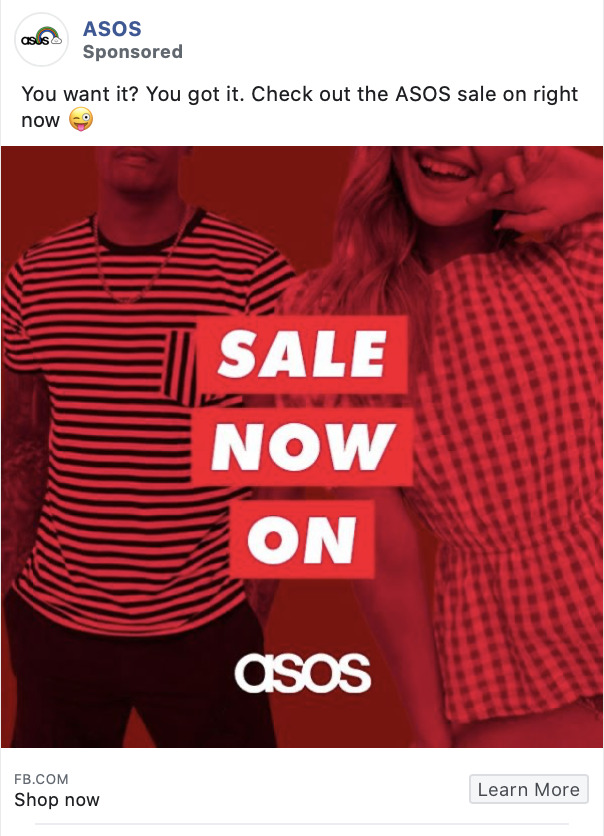
Asos owns an online fashion store
But Facebook and Instagram ads are also relevant for all kinds of other businesses: grocery stores, design brands, electronics & gadgets, and much much more.
If you’re running an online store and haven’t tried Facebook and Instagram advertising yet, do it now!
There’s plenty of case studies out there proving that Facebook ads can deliver a high return on investment.
- Mixit, an online muesli retailer achieved their best-ever sales performance – a 60% increase – in a Valentine’s Day campaign on Facebook.
- Neuhaus, the renowned Belgian chocolatier doubled their online conversions by retargeting audiences with multi-language and country’specific Facebook dynamic ads.
- The online cosmetics store We Makeup reached a 7.9-point lift in brand awareness thanks to Facebook’s Augmented Reality ads.
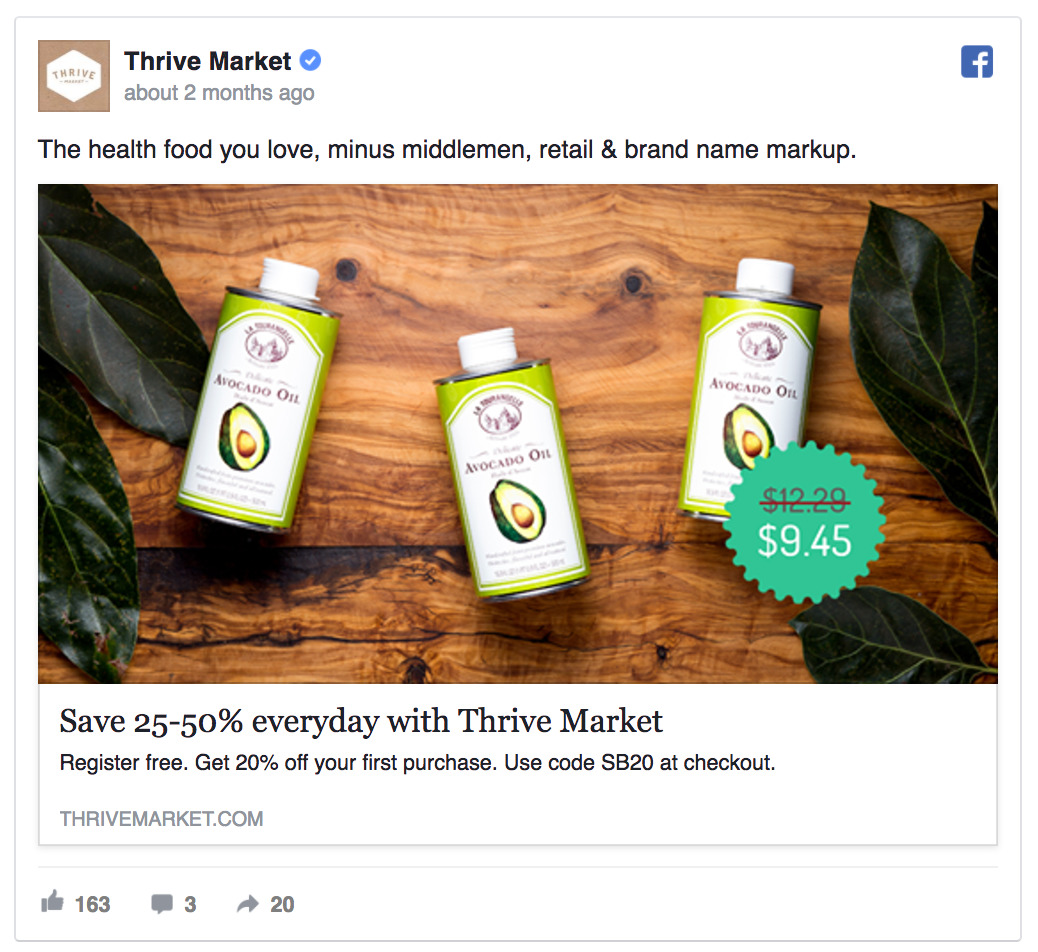
Facebook ads are a good fit for all kinds of online retailers
What is a good Facebook ad strategy for online stores?
Firstly, you’ll want to know what your desired result is. Is it…
- Increase in online store traffic? – Set up a Facebook campaign using the Traffic objective.
- Increase in purchases? – Set up a campaign that has Conversions as the objective.
- Raising brand awareness? – Run a campaign with a Brand Awareness focus.
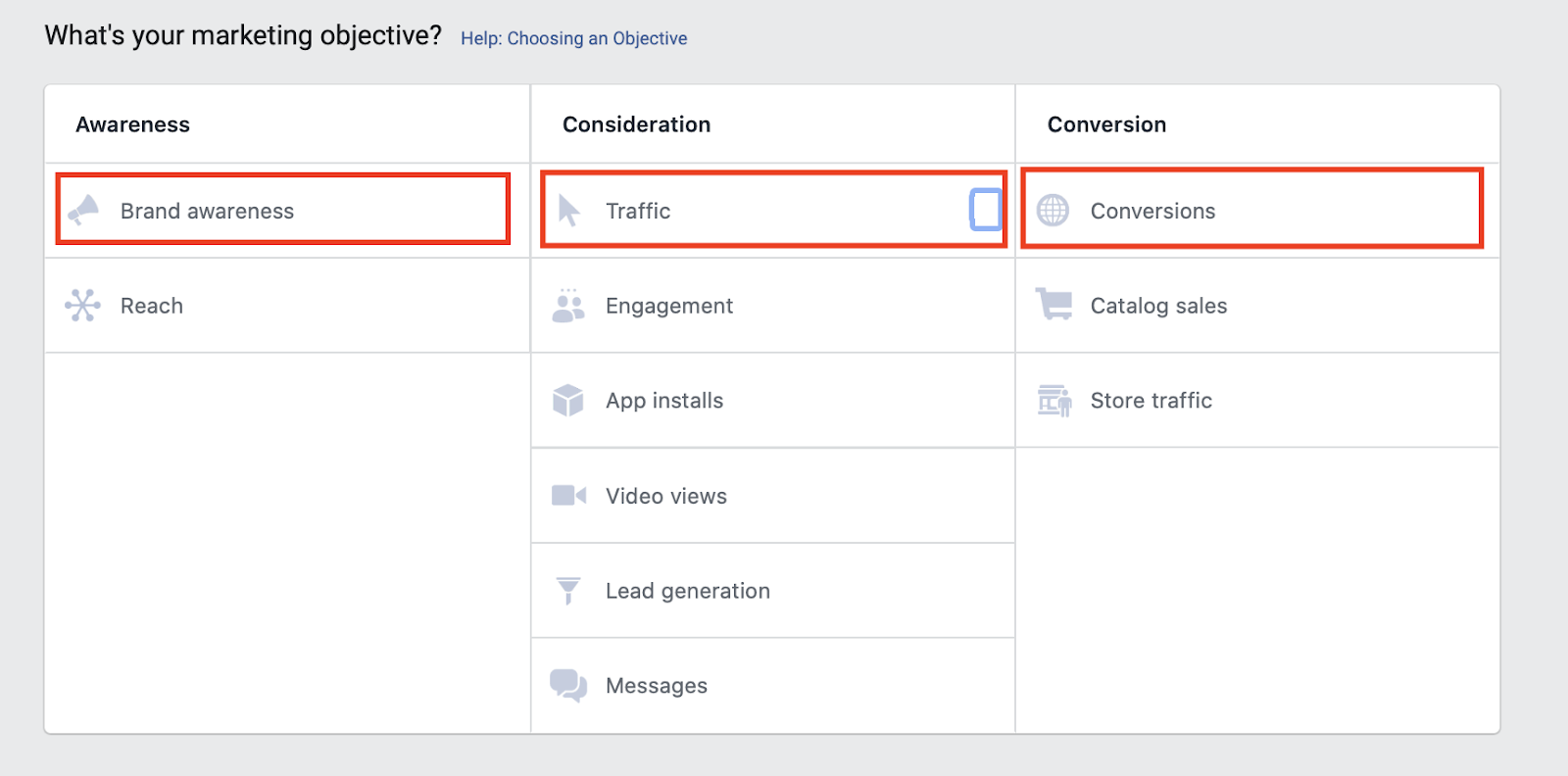
Select the correct campaign objective
Another popular Facebook ad strategy for online stores and eCommerce is using Catalog ads.
This requires you to upload your product catalog to Facebook and set up dynamic ads that showcase the products in your online store.
We’ve seen many brands achieve higher CTRs when replacing their static image ads with catalog ads.
Here’s an example of what a catalog ad looks like:

Catalog ad example
Tip: When setting up a Facebook ad campaign to raise brand awareness or lead new potential purchasers to your online store, don’t forget to set up a retargeting campaign.
💰 5 suggestions for Facebook ad campaigns for online stores:
- Optimize your ad delivery on purchases to reach people who are most likely to place an order.
- Showcase your products in ads, so that it’s clear what’s being advertised. You will also raise awareness about your products.
- Run frequent discount campaigns – buyers love discounts and you’ll be able to boost your online store sales for a set period of time.
- Test different ad formats: single image ads, video ads, collection ads, carousel ads, etc. to find out what format has the best click-through rates and brings the most revenue.
- Keep your ad set targeting broad and leave room for Facebook algorithms to optimize the ad delivery based on the data collected through Facebook Pixel.
2. Facebook ad strategy for B2B companies
In general, Facebook ads are more profitable for B2C companies. But this doesn’t mean that a B2B company can’t run any ads on Facebook and profit from it.
In fact, there are plenty of examples of B2B brands successfully advertising on Facebook. For example, the project management tool Asana…
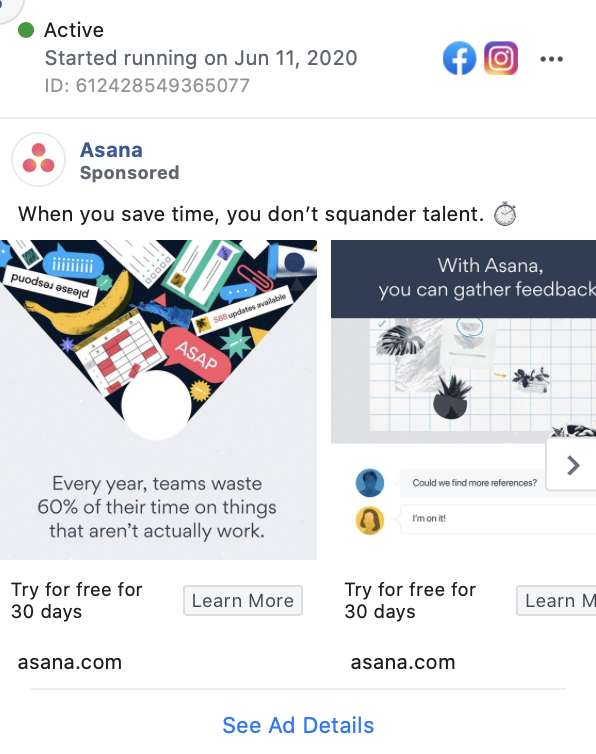
Asana is running B2B ads
Or the workplace messaging app Slack.
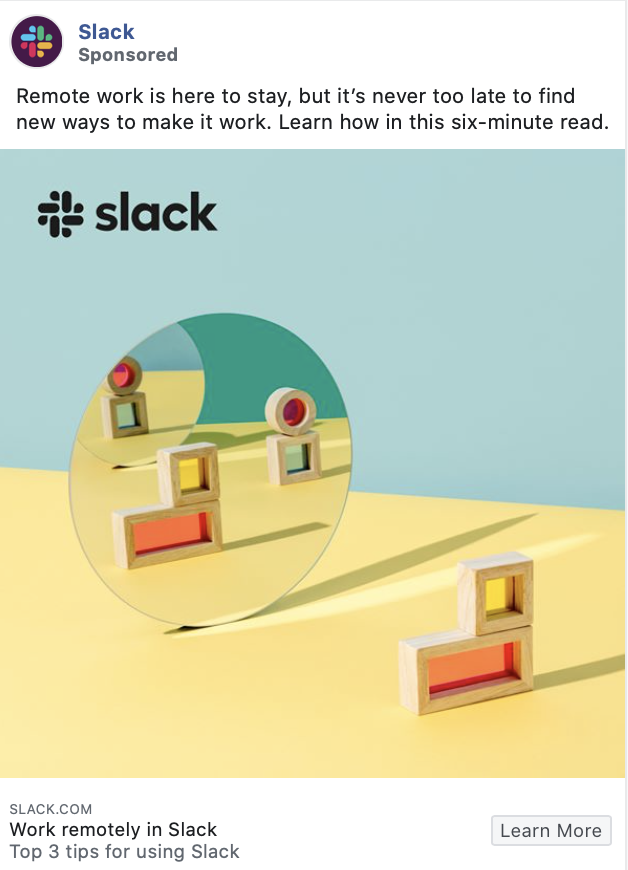
Slack gets new users through Facebook ads
Want some extra proof that B2B Facebook ads work? Here are 3 case studies by Facebook:
- MailChimp ran Facebook and Instagram video ads to boost and measure brand awareness, which resulted in an 18-point lift in ad recall.
- Drip ran a Facebook campaign to sign up for its virtual conference, achieving 6X more signups from Facebook than organic and paid search combined.
- Source-One used the WhatsApp Business API (part of Facebook’s ad network) to constantly stay in touch with customers and business partners, which resulted in a 30% monthly increase in revenue.
However, the B2B Facebook ad strategy is somewhat different from consumer-targeted ads. As a B2B brand, you will get a higher ROI when using Facebook as a lead nurturing and remarketing channel rather than running cold acquisition campaigns.
Learn more: B2B Facebook Ads – The Complete Guide to Grow Sales in 2020
If you’re setting up a B2B Facebook advertising strategy, think about various marketing funnel stages and create a streamlined campaign flow for each step in the funnel.
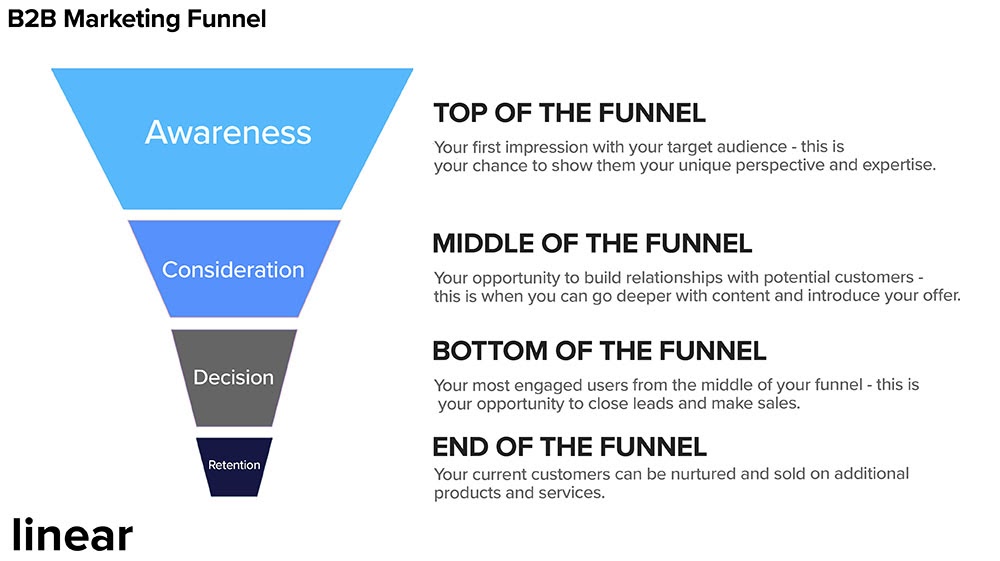
Create a Facebook campaign for each funnel stage
- Awareness: Raise awareness about your product/service.
- Consideration: Share useful content that will nudge the potential B2B clients to try out your product.
- Decision: Offer a free trial or discount to help people decide whether they like and need your product.
- Retention: Upsell customers to higher packages, better products, or additional services.
Each of the funnel stages can be set up as a different Facebook ad campaign so that you can move the B2B leads from one stage to another.
💰 5 suggestions for Facebook ad campaigns for B2B products:
- Instead of cold sales-oriented campaigns, set up a B2B marketing funnel to first get people’s interest and only ask them to purchase your product in a later stage.
- Use Facebook ads to promote content – e-books, blog articles, webinars – to first offer value to new potential leads.
- Target your ad delivery to desktop placements if the product (e.g. software) is used on desktop.
- Include Facebook ads in your overall sales funnel to help close more deals through helpful content marketing.
- Set up remarketing campaigns to reach B2B leads in different stages of your marketing funnel: ad engagement, landing page visitors, free trial users, etc.
3. Facebook ad strategy for marketplaces
Marketplaces are companies that sit in between service providers and customers, providing them a platform for meeting each other.
To give you some examples, Uber and Lyft are marketplaces between drivers and riders. And DoorDash has a 3-sided marketplace that brings together restaurants, couriers, and customers ordering the food.
Having multiple parties using your product also means that you need to have a Facebook PPC strategy for all sides of the equation.
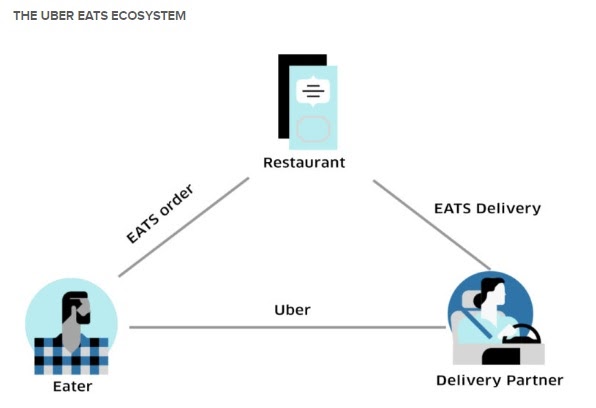
Marketplaces have multiple sides to the business – Image source
For example, Uber is running ads to attract new riders…
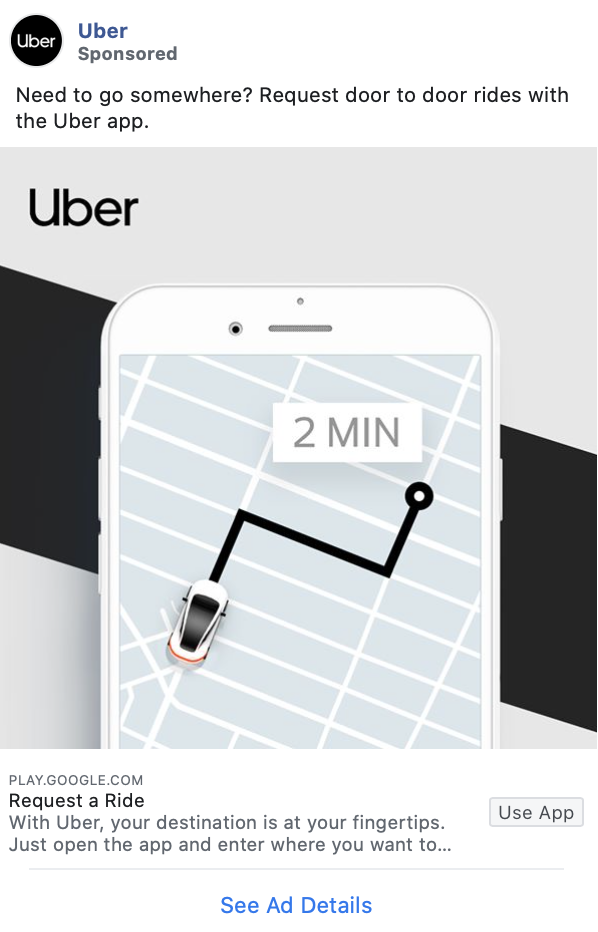
Uber rider ad
But they’re also using Facebook ads to acquire new drivers.
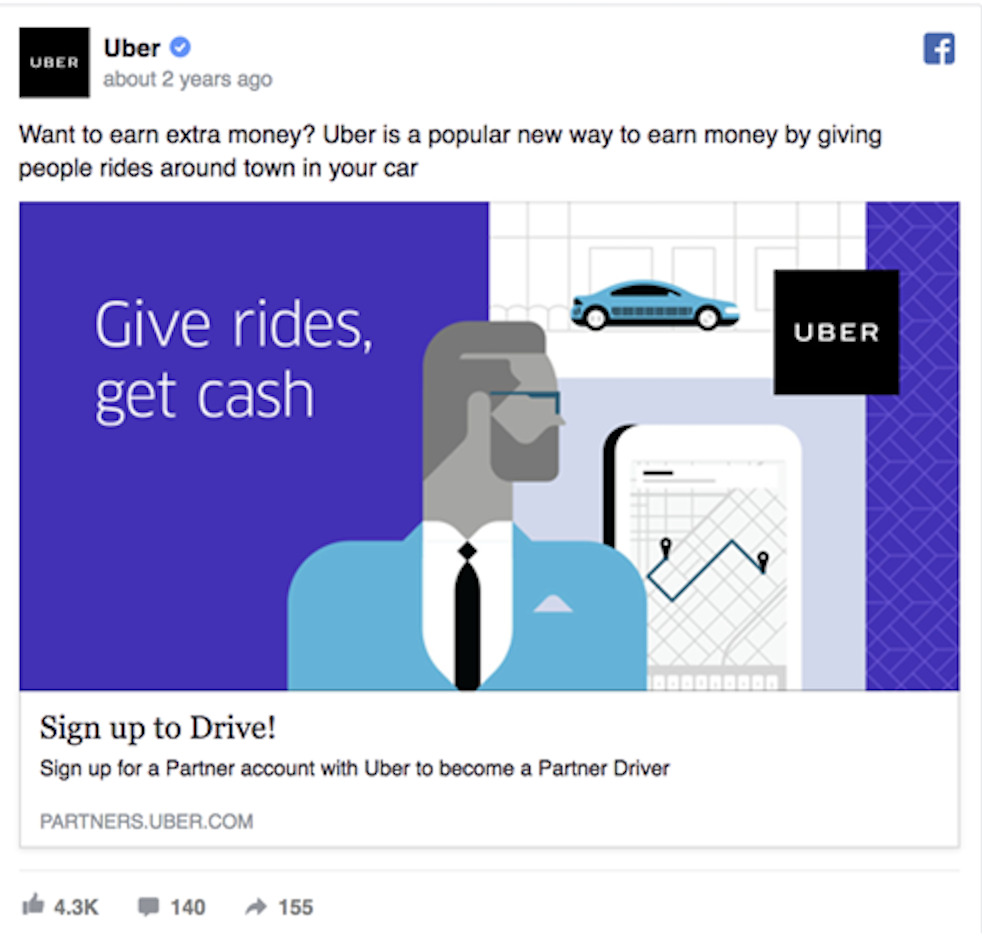
Uber driver ad
When setting up a Facebook ad strategy for a marketplace, keep in mind that you need to grow both sides in a balanced way.
If you have too many people on the customer side, but not enough suppliers to serve the demand, you will end up with a poor user experience.
💰 5 suggestions for Facebook ad campaigns for marketplaces:
- Have a separate ad strategy for each party in the marketplace, e.g. for customers, service providers, and middle-men if you also have those.
- Keep a balance by adjusting ad budgets – you can control how many new users you bring to either side of your marketplace by lowering/increasing the ad spend.
- Have different ad creatives and messaging for each side of the marketplace. This also means that you will need to set up different ad campaigns.
- Track different metrics and KPIs to measure the success and ROI of all your Facebok ad campaigns.
- Run Facebook brand awareness campaigns to let all sides of your marketplace know about your product and boost the organic signups.
Uber Eats UEA used Facebook ads that lead to Messenger to 70% more app installs, compared to ads that clicked to the app.
4. Facebook ad strategy for mobile applications
In the past few years, more and more people have shifted to their mobile devices for simple daily activities and communication with friends and family.
According to some resources, as much as 96% of Facebook users have accessed the platform on their mobile devices.
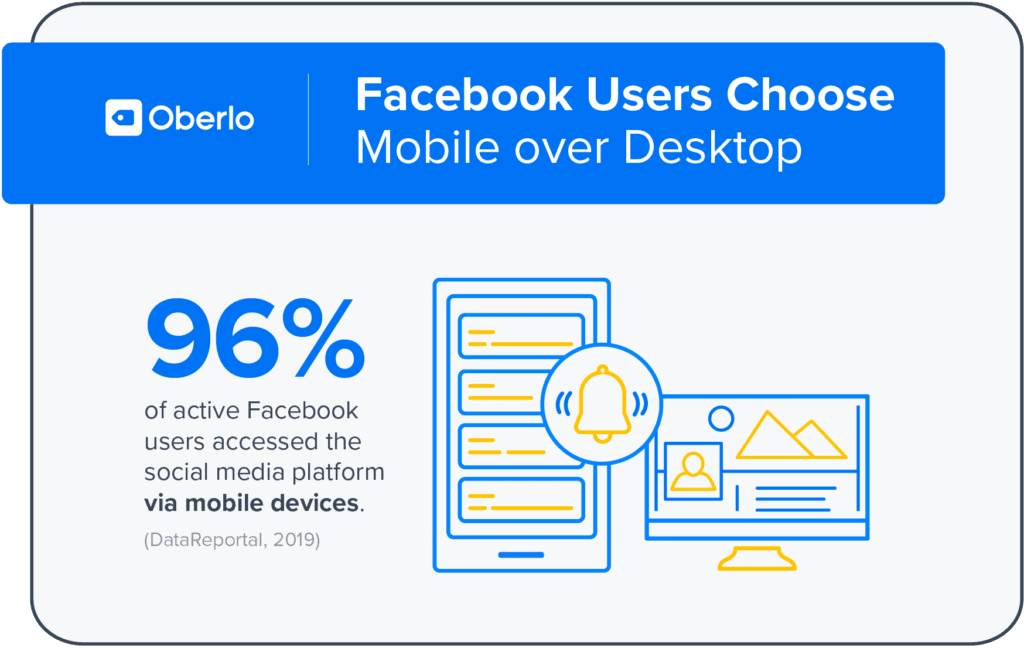
Most Facebook visits happen on mobile devices – Image source
Naturally, the shift to mobile is good news for mobile app developers – and makes Facebook the perfect platform for acquiring new app users.
For example, the ride-hailing app Bolt uses Facebook mobile app ads to get new app installs.
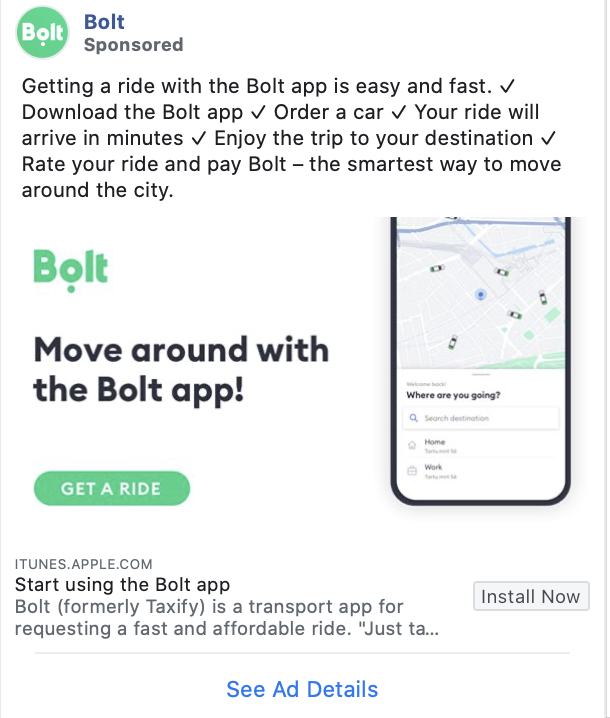
Bolt is running mobile app install ads
And here’s one more example from the newly-launched Whatifi app for watching interactive movies with friends.
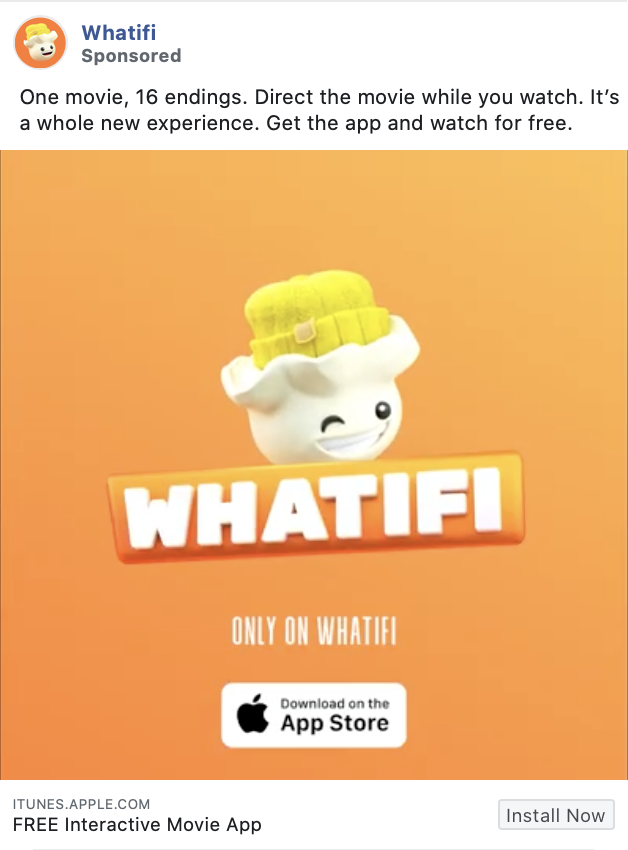
Notice the app store icon in the ad creative 😉
The Facebook ad strategy for mobile apps is somewhat different from online stores and B2B brands.
For one, you will need to drive mobile app installs, so it makes sense that you lead people to the App Store after they click on your app.
Facebook has the option to set up these kinds of special app install ads.
Simply select the “App installs” campaign objective when setting up your Facebook ad campaign.
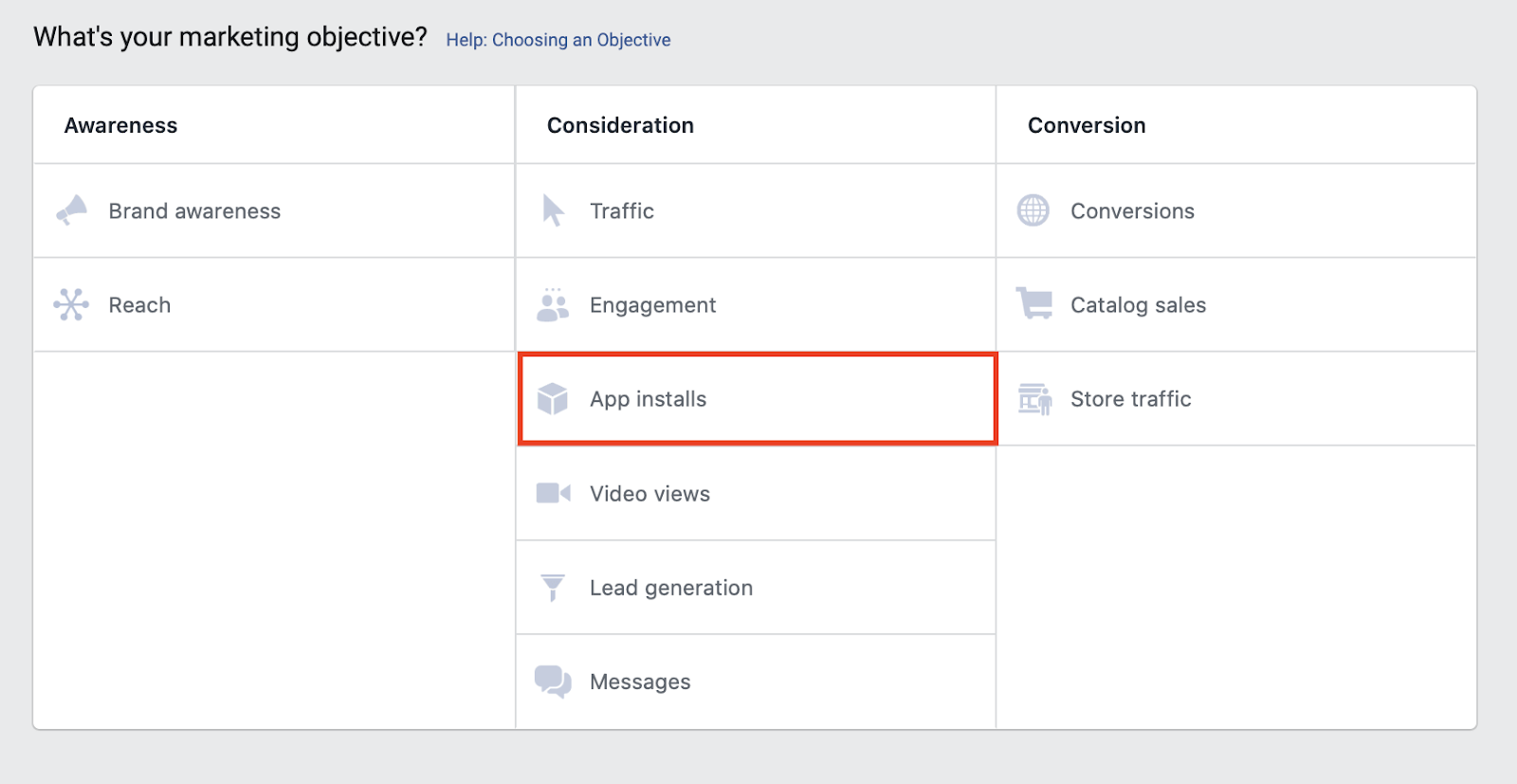
Select the “App installs” campaign objective
When using this campaign objective, Facebook will guide you through all the other necessary steps of the setup process. Like selecting which app you want to advertise.
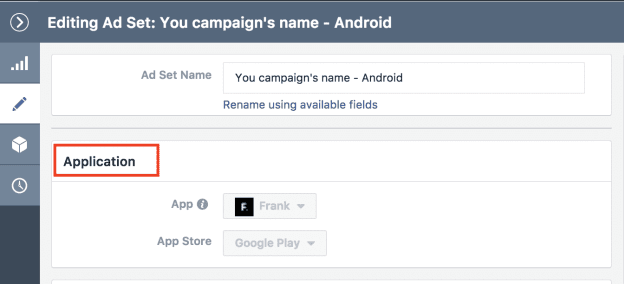
You can lead users directly to the App Store
💰 5 suggestions for Facebook ad campaigns for mobile apps:
- Use the “App install” campaign objective and lead users to the App Store after they click on the ad.
- You will need to set up 2 ad sets per campaign – for App Store (iPhone users) and Google Play (Android users)
- Show your app in the ad image so that people will immediately understand that you’re promoting a mobile app.
- Include numbers in your ad creative – your App Store rating, the number of people using your app, and the number of positive reviews – as suggested in this guide for Facebook mobile app install ads.
- Set up app engagement campaigns to retarget inactive app users and bring them back.
Want to create better Facebook ad creatives? See these 36 Facebook ad examples for inspiration.
5. Facebook ad strategy for raising brand awareness
According to research, 65% of people surveyed have felt an emotional connection with a brand. Strong brand awareness helps to drive organic sales and also make all paid advertising more efficient. 🔥
You don’t have to believe us out of the blue. But check out these case studies:
- Colgate ran a mobile-first video campaign across Facebook and Instagram which resulted in 1.8X return on ad spend for all Colgate products.
- Eurail reached 7.7X more link clicks from mobile-friendly animated video ads in a Facebook campaign to build awareness and consideration.
- Carlsberg saw a 19X return on ad spend after using Facebook and Instagram to generate excitement and positive brand associations with its sponsorship of a sports club.

Strong brand can have a magical effect – Image source
In general, big brands include Facebook brand awareness ads in their general brand marketing strategy. These campaigns do not have to drive direct sales but build a positive brand in the long run.
One such example is this Facebook ad by Volvo. It showcases a 15-second branded video with the company’s key message around safety. (Volvo has been putting a lot of effort into branding its cars as some of the safest in the world.)
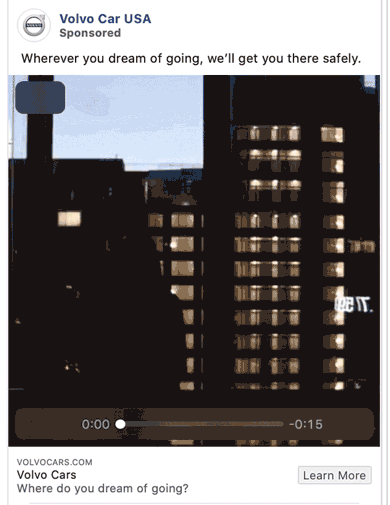
Examples of a Facebook brand awareness ad
Another potential use case for Facebook ads is to promote the awesome stuff your company is doing to a wider audience. For example, Lyft is promoting their special program for increasing safety on their rides.
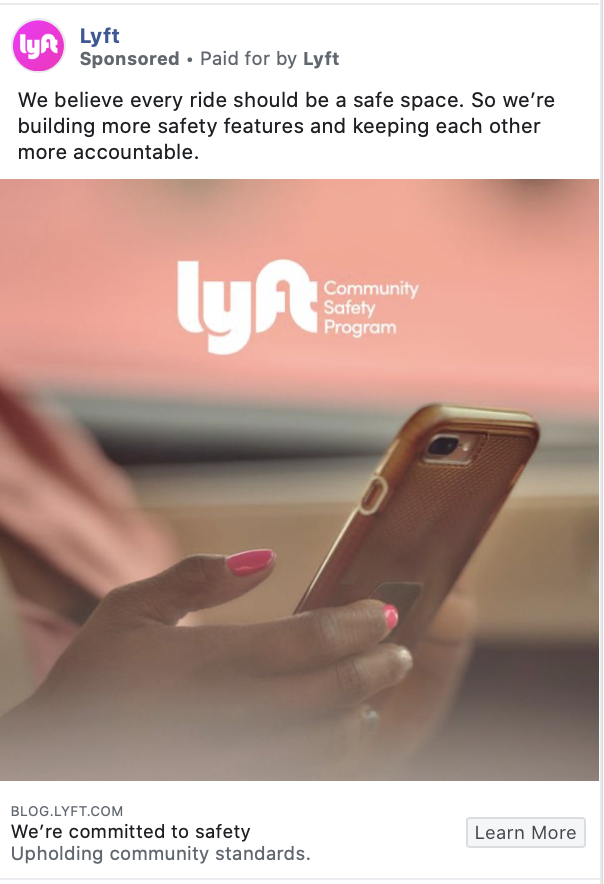
Lyft’s ad is reminding people about their commitment to safety
The goal of brand awareness ads isn’t to immediately convert the viewers into customers. It is more about reaching a big audience and building a positive acknowledgment about your products.
To set up a brand awareness campaign in the Facebook Ads Manager, select the – you guessed it! – “Brand Awareness” campaign objective.
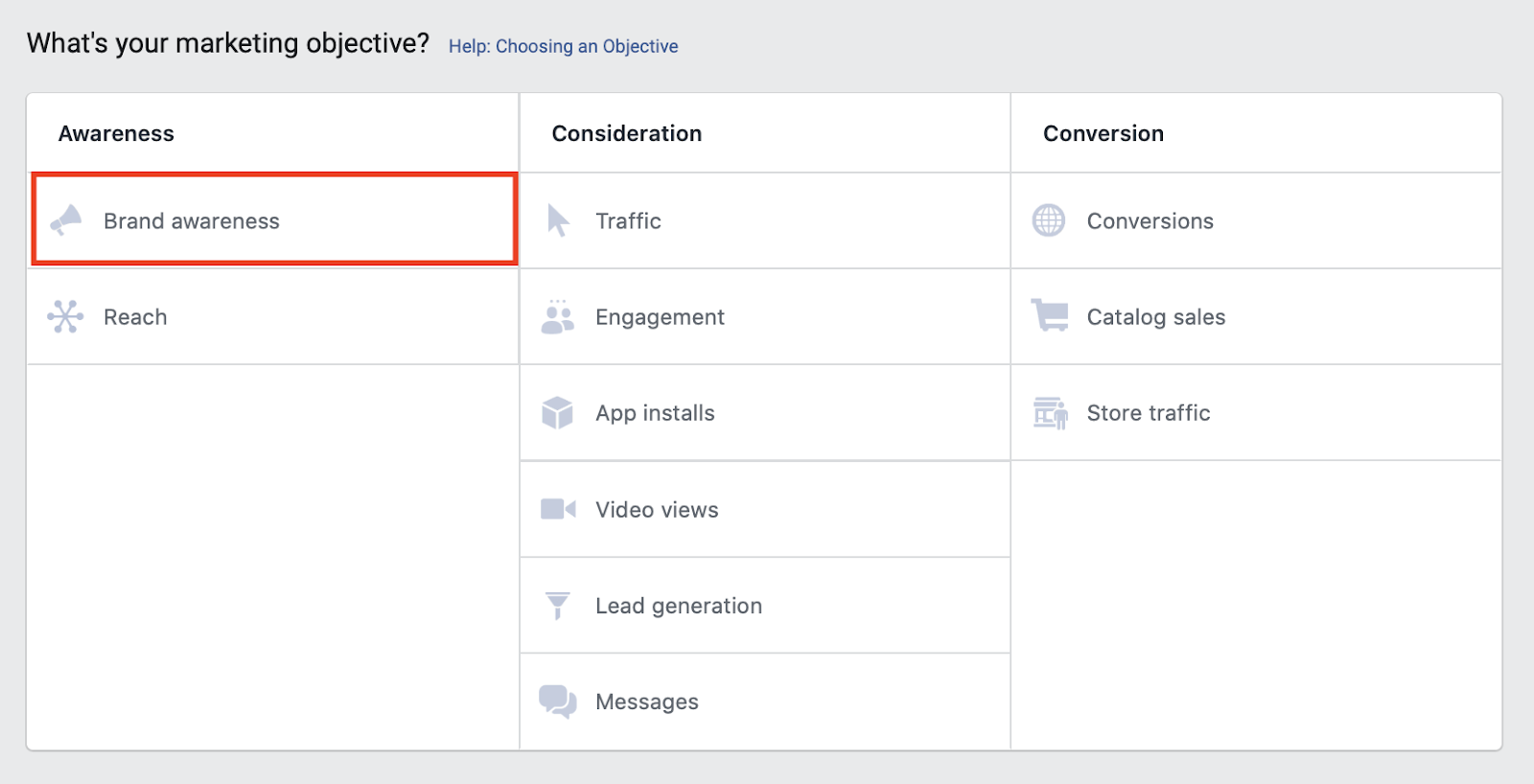
Use the “Brand Awareness” campaign objective
💰 5 suggestions for Facebook ad campaigns for brand awareness:
- Facebook suggests to run brand awareness ads simultaneously with acquisition campaigns so that they complement each other.
- Video ads generally outperform static image ads in brand awareness campaigns.
- Keep your brand building ads’ key messages close to your core branding and use the same message continuously.
- Measure the “Ad Recall Lift” metric and the Facebook Relevance Score to evaluate the performance of your brand ads strategy.
- Work with social media influencers to create compelling video content for your Facebook brand awareness campaigns.
Tip: Facebook offers brand awareness ads with a complimentary Brand Lift Study that helps you measure the ROI of running such ad campaigns. You can set it up in the Facebook Ads Manager.
Alright! Now that you’re aware of the various Facebook ad strategies, let’s take a look at 20+ additional tips and best practices – so that you can get better results no matter what strategy you decide to follow.
💡 22 Facebook ad tips & suggestions to make your ad strategy a winner
1. Install the Facebook Pixel
There’s a lot of exciting Facebook ad strategies that this article covers. This is not one of them, but like most things in life, you’ve gotta walk before you can run.
In this case, you need to install the Facebook conversion tracking pixel so you can create Facebook Custom Audiences and measure your ads’ results to make sure your Facebook campaigns are on track.
This is especially relevant for Facebook ad strategies that help to drive sales and other types of conversions. You’ll want to be able to track the results, right?

Keep an eye on your Facebook ad results – Image source
To install your tracking pixel, you’ll need to do the following:
1. Go to your Pixels tab in the Facebook Events Manager
2. Click on “Create a Pixel”
3. Click the green button at the bottom titled “Create a Pixel”
Next, you’ll need to add the pixel to your website. Here’s the step by step:
1. Go to the Pixels tab in the Events Manager
2. Click on “Set Up Pixel”
3. Click on “Manually Install the Code Yourself” to view your code
Add the Pixel to your website
We recommend using Google Tag Manager to manage and unify all your tracking codes. In Tag Manager, you can add your Facebook pixel and apply it to pages you want to track.
Here are the step-by-step guidelines for Google Tag Manager:
1. Go to your Tags tab
2. Click on “NEW”
3. Click the pencil in the upper right corner of the Tag Configuration box.
4. Click on “Custom HTML” from the pop-out.
5. Copy and paste your Facebook pixel code into the container
6. Click the pencil in the upper right corner of the Triggering box
7. Select “All Pages”
8. Click the blue add button in the upper right corner
9. Click the blue save button in the upper right corner
For a more detailed guide to installing Facebook Pixel with Google Tag Manager, read this: Using Facebook pixel with Google Tag Manager
If you choose not to use Tag Manager you can still use Facebook Pixel. Just copy the code and paste it between the tags on each web page. Similarly, you can paste it in the tracking code section on your website template to install it sitewide.
You can find a more thorough guide to installing Facebook Pixel on your website here: Using Facebook Pixel
2. Create customer personas
You’ll have an overwhelming number of targeting options when you begin your Facebook ads journey.
So before you even start, it’s best that you know who your target audience is.
Like, where they’re located, what their interests are, what pain points they have, and how they make purchasing decisions.
We’ve found that the best way to identify your target audience is to create a customer persona. 👩🎨

Find out who your ideal customer is – Image source
By definition, a persona is the aspect of one’s character that is perceived by others, and according to Hubspot.com:
“A buyer(customer) persona is a semi-fictional representation of your ideal customer based on market research and real data about your existing customers.”
In simpler terms, customer personas are kind of like fictitious characters that represent your ideal customer and define groups of your audience.
The good news is it’s actually easier to create customer personas than you might think.
Customer personas can be created using many different methods. You can use surveys and interviews with your current customers or study the data you have about them already.
You can also use web forms that capture relevant persona-building information. Here’s a link to the persona questionnaire we created to help us get to know our clients’ target audience and build better customer personas. Feel free to copy it for your own use. 😉
If you still feel a bit lost, here’s an example of what your customer persona could look like:
Healthy Heather customer persona
Name: Healthy Heather
Age: 35-45
Details:
– iPhone user
– Homeowner
– Married with two kids
– Decision maker for the family’s healthcare
Here’s an example of how you could put this persona to use:
You promote articles about stretches her husband can easily do at his desk job to prevent back pain. Healthy Heather reads and appreciates the blog articles you’re promoting on Facebook.
Now you’ve secured her as a potential customer. It’s also likely that she’ll share your content with her friends and family, who may also share it. See where I’m going with this?
Want a visual example? Here’s a persona we made to improve Facebook ad targeting for a flight school:
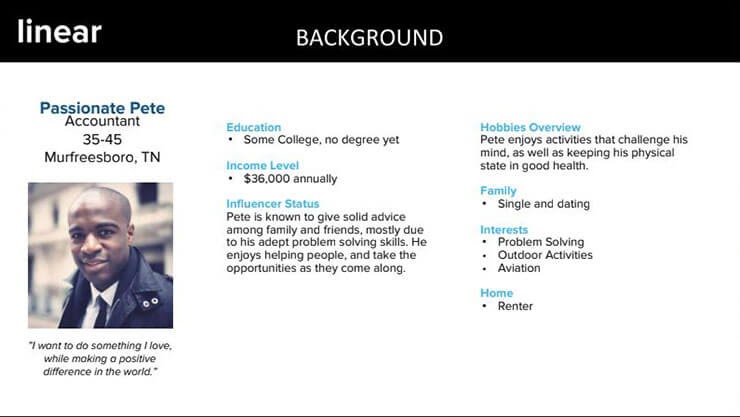
Create a customer profile that you can use for Facebook target audience setup
Now that you know who your ideal customer is, you’ll be able to target the right audience and deliver content that your customers find useful and relevant.
You may think this is too much work, but I promise you the time spent developing your customer persona will help you better execute the other Facebook ad strategies in this article.
3. Understand the buyers’ journey
The buyer’s journey refers to the steps customers take leading up to a purchase.
Your buyer’s journey can be simple or complex depending on the products or services you offer. But according to research from Google and CEB, one thing stands true for every potential buyer. Nearly 70% of the buyer’s journey is completed before a potential buyer reaches out to a company.
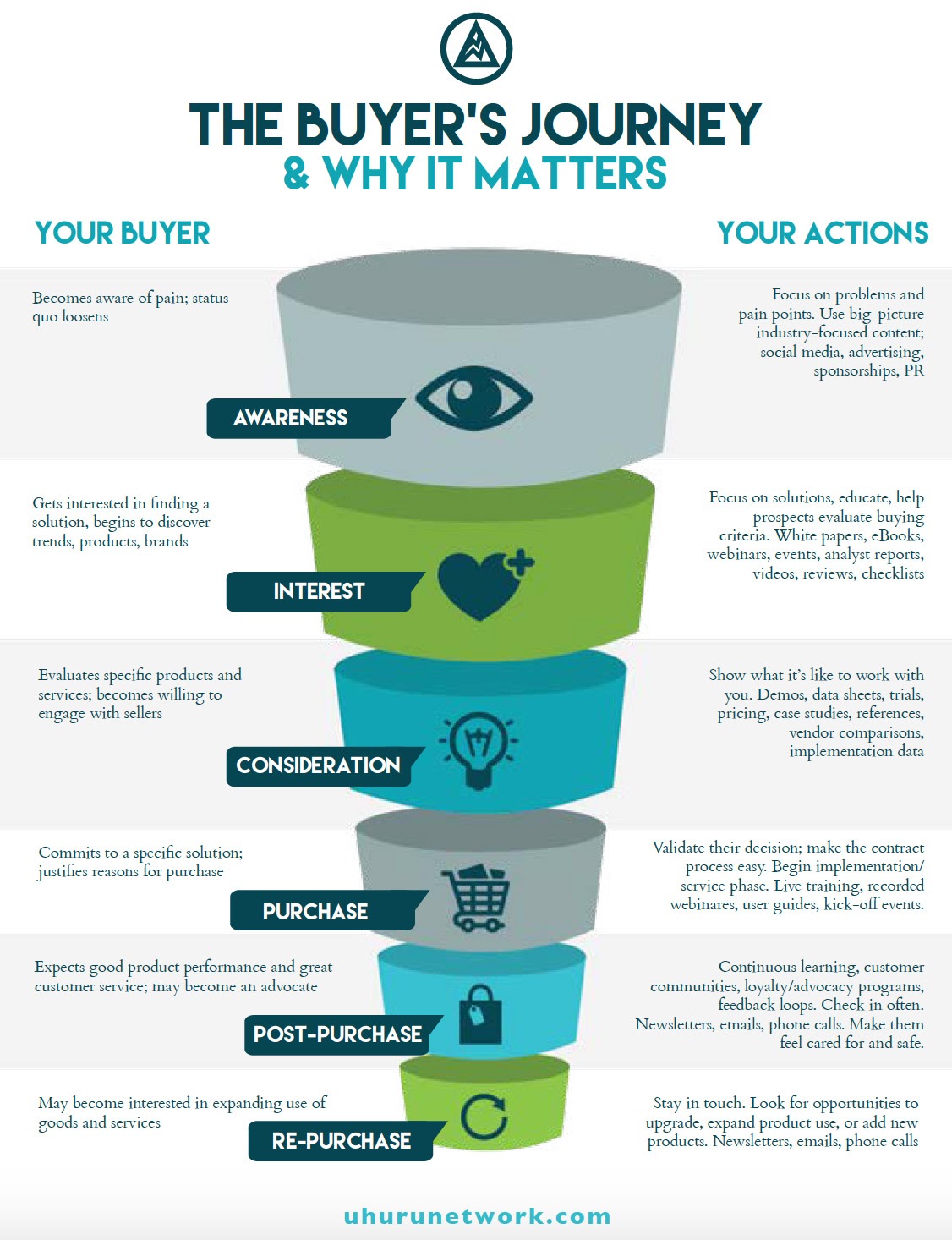
There are many possible buyer’s journey stages – Image source
Of course, you’d like to play an active part in guiding potential customers through the buyer’s journey and right to your company’s product or service.
Not all stages are relevant to all advertisers.
First, you’ll need to understand the buyer’s journey and what takes place along the way.
To help you get started, we’ve outlined the three most common stages of the buyer’s journey.
👍 Awareness
In the awareness stage of the buyer’s journey, your customers are just barely identifying a problem they have. So, they begin researching possible solutions.
🔎 Consideration
Research, research, research! Your potential buyer is still researching. However, they are beginning to narrow down and zoom in on a smaller number of solutions.
🎁 Decision
The decision stage is the last phase of the buyer’s journey. This is the final push to get the buyer to decide on you!
Below, you can check out a visual example of the buyer’s journey. We created this to help us understand how Pete (our client’s ideal customer) makes purchasing decisions.
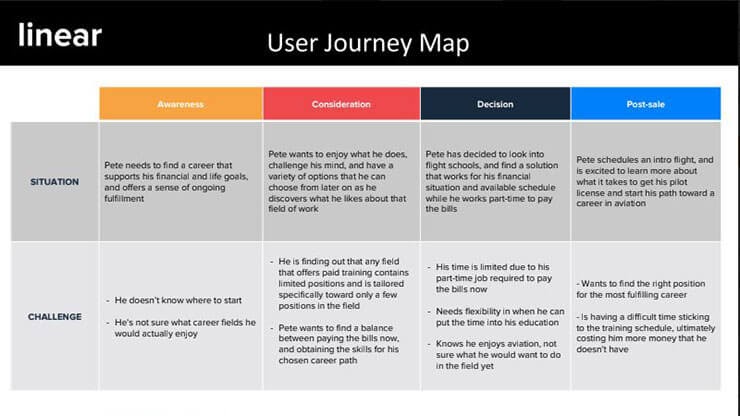
Example of a user journey map
Understanding your buyer’s journey will help you apply the right Facebook ad strategy and maximize your results.
4. Plan your conversion funnel
It’s important to note the differences between the buyer’s journey and your conversion funnel.
While the buyer’s journey represents your customer’s decision-making process, your conversion funnel maps out the tactics you’ll use to guide their decision. 🗺️
Think of your conversion funnel and your buyer’s journey like velcro. Your buyer’s journey is the soft fluffy loops, and your conversion funnel is the pointy spikes that grab on and stick you together.
Your conversion funnel typically has four core components: attract, engage, convert, and delight. This means you’ll need different Facebook campaign strategies, audiences, ad types, and content for each stage of your funnel.
Here’s a visual breakdown of a conversion funnel and the offers we’ve found that perform the best during each stage:
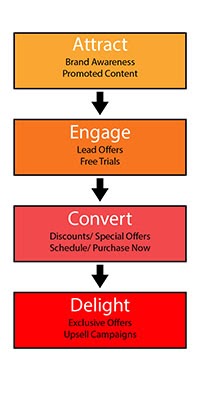
Multi-stage Facebook ad strategy example
If set up correctly, your conversion funnel should successfully move prospects from one stage to the next.
Eventually, it should take them all the way down the funnel to the purchase.
5. Target various customer segments
If you’ve followed this guide so far, you’ve found your perfect customer (customer persona), gained a solid understanding of your customer’s behavior (buyer’s journey), and created content offers to target each stage of the buyer’s journey (conversion funnel).
Now, it’s time to create Facebook audiences to differentiate all those customers.
The goals here are to divide your website visitors out into bite-sized pieces based on their behavior. Then put those pieces into groups corresponding with their stage in your conversion funnel.
For example, someone who has read two or three of your blogs and downloaded your eBook is much more likely to convert than a first-time visitor or someone who’s never heard of you before.
You should also create different Facebook ads for each of your customer segments.
For example, HubSpot is promoting their podcast to raise brand awareness. However, this ad won’t get them any new signups – that goal is achieved with other ads to a more interested audience.
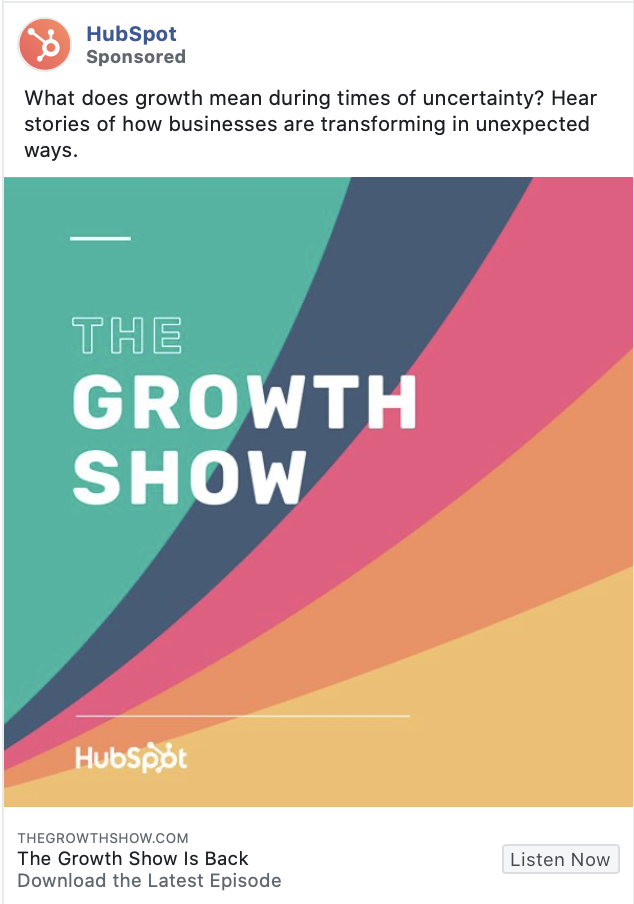
HubSpot is promoting their podcast
Luckily for you, Facebook makes it easy to segment your customers using Facebook Saved Audiences.
If you don’t have enough website traffic then you may not see immediate results from your remarketing efforts. You’ll need to focus on building the top of your funnel. You can do this by promoting blog content, brand awareness campaigns, and content offers.
Once you have a steady stream of visitors, you’ll be able to identify behavior patterns. Then you can use these patterns to create customer segments for retargeting.
Remarketing is one of the most powerful tools in the world of PPC and Facebook PPC is no different. We’ve seen a lot of Facebook retargeting campaigns in our time. So save yourself some guesswork and start by building the customer segments we’ve seen perform well for others.
First-time visitors
Your first-time visitors are typically customers in the attract stage of your conversion funnel. They may have stumbled across a promoted blog article or clicked on a brand awareness ad.
Repeat visitors
Your repeat visitors are those customers that are starting to move into the engage stage of your funnel. Although, they may still have some more research to do before they make a decision.
Engaged visitors
These are customers that regularly visit your blog and stay on your website longer than others. They might be comparing their options as they move closer to making a decision.
Landing page visitors
Customers who visit your landing page are closest to converting. They may have read several blogs, downloaded your eBook, and are ready to convert.
Here’s a great Facebook ad example of landing page retargeting from Esurance.
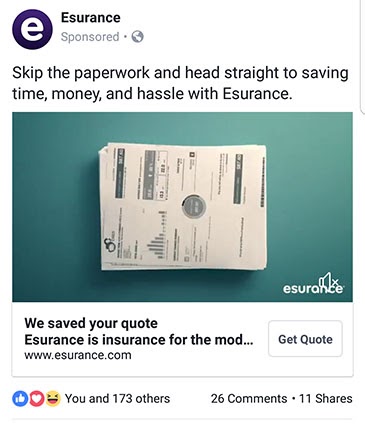
Esurance remarketing ad
Repeat customers
People that have purchased from you once or twice and keep coming back are your potential fans. They’re more likely to refer friends and family to you and become a brand advocate.
Over time you’ll be able to create more relevant offers and identify new customer segments.
We’ve found the best way to save time and maximize your efficiency is to frontload all your audience creation. As a result, it’s there when you need it.
We created a list of the 42 most common Facebook audiences. We even ordered them from hot to cold in terms of where these audiences usually sit in the conversion funnel.
You can get all these for yourself when you download our cheat sheet.
GET MY FREE FACEBOOK AUDIENCES CHEAT SHEET
Pro tip: There’s one more interesting thing to keep in mind when creating a strategy for Facebook remarketing campaigns: you can reach a high ad frequency and still get great results.
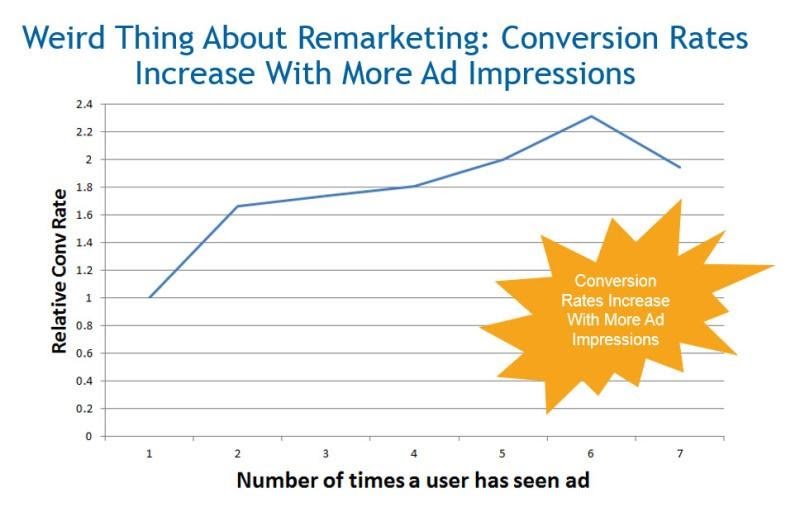
Facebook remarketing ads can have a high frequency – Image source
6. Drive traffic to your blog
If you’re running cold targeted Facebook ads asking people to sign up, buy now, or schedule an appointment you’re probably falling flat on your face

Running only sales-oriented Facebook campaigns doesn’t work – Image source
People are reluctant to buy a product they’ve only just learned about. You’ll need to do some lead nurturing.
Hopefully, you’re already whipping up some magical blog articles to draw more traffic to your site. If you are, it’s time to put your content marketing on steroids and start generating some site traffic.
For example, the recruitment app MeetFrank is using Facebook ads to regularly driver additional traffic to their blog.
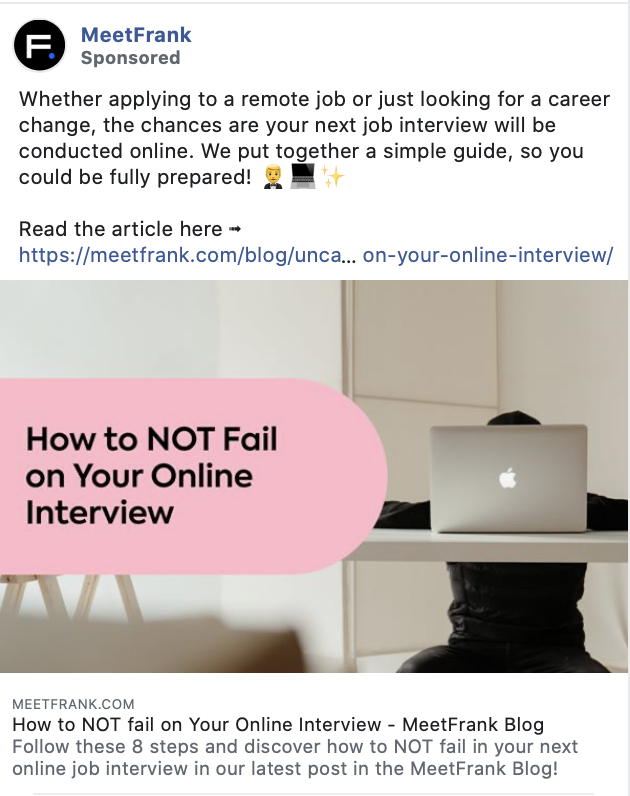
MeetFrank is promoting their blog articles
Here are a few benefits of promoting your content on Facebook:
- It’s a cost-effective way to attract site visitors, warm them up, and drop them into your remarketing funnel.
- You’ll attract higher quality site visitors that are likely to be interested in your products and services. This makes your remarketing and lookalike audiences stronger, and your results will increase over time.
- It’s likely that other authors will read your promoted content and may link to it in future articles. This can increase site traffic and have an impact on your SEO efforts.
This approach fits perfectly with your conversion funnel and primes your remarketing efforts for later stages. That’s because a person who’s read a few of your blogs is now familiar with your brand. This means they’ll be more likely to participate in a contest, download an eBook, or take advantage of free trial offers.
Pro tip: When promoting your blog content on Facebook we’ve seen better results when leaving the button out of the ad.
That means you’ll want to steer clear of the dynamic creative option Facebook now offers. It makes the ad look more organic and less salesy when there is no CTA. Remember that people at this stage want to learn more about whatever it is they are researching. However, they may not be interested in purchasing right away.
7. Promote a short video
Video is becoming increasingly popular on Facebook and other social media platforms. This doesn’t mean video should be your only approach. However, there’s plenty of good reasons to include video in your Facebook ad Strategies.
For starters, buyer’s in all stages of the journey turn to video for information. Which makes it a great way to build awareness, engage, or convert customers. And if that doesn’t have you convinced video ads have been shown to have a lower estimated CPC and a higher conversion rate than other ad types.
Here’s a video ad by MeUndies that got over 17M views:
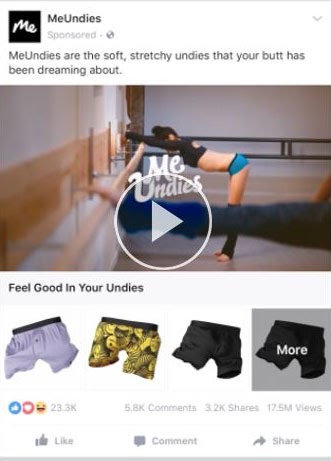
Video ads get a lot of views
Facebook video ads are used by some of the biggest brands in the world. Like other ad types, your video still needs to be relevant to your customer. 😉
When it comes to what kind of videos you can use the options are almost limitless. Up next, we’ll share a few video types that you could create:
Explainer videos
These videos are a great way to provide useful content to your potential customer base.
You can show potential customers how your product or service works, or teach existing customers about new products and services.
Take a look at this Facebook ad by ZenWell that uses an explainer video:
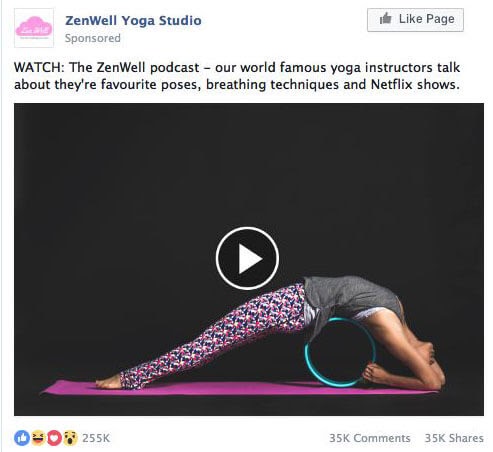
Explainer video ad example
Testimonial videos
These videos are a great way to nudge customers into making a decision. Video testimonials carry more weight than written reviews and tend to be more believable when done correctly.
Features & benefits videos
This is probably the most common Facebook ad video type out there – that’s because it works!
For example, Restream’s Facebook video ad is showing its product features in a quick 15-second video. After watching it, people will have a much clearer understanding of how the product can benefit them.
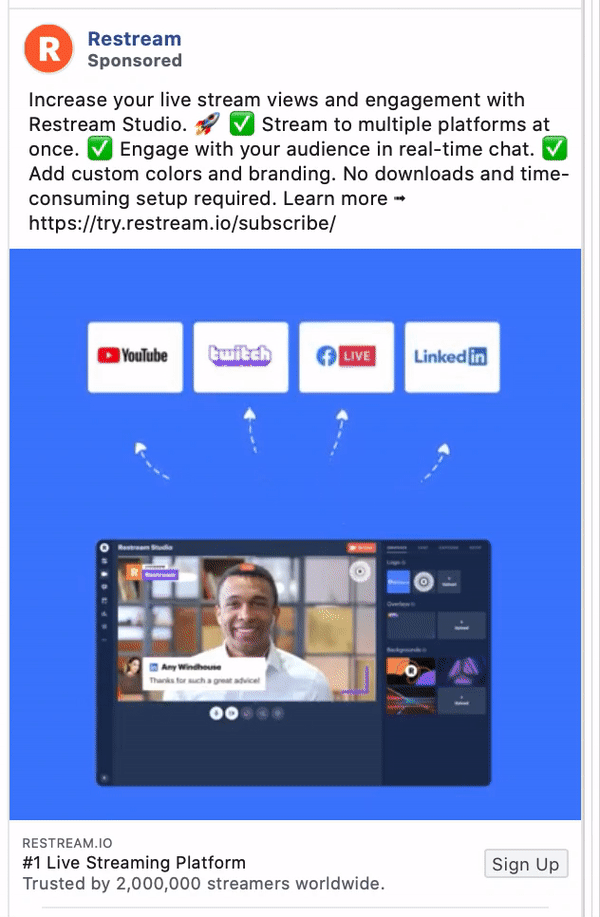
Restream’s video ad shows how the product works
Restream’s video ad shows how the product works
Screen capture videos
If your a SaaS company or your product or service is digital-only and therefore intangible, then this will be your go-to for Facebook video ads. You can use it to explain your service, highlight unique features, benefits, and more.
Here’s an example of a screen capture video ad from ActiveCampaign:
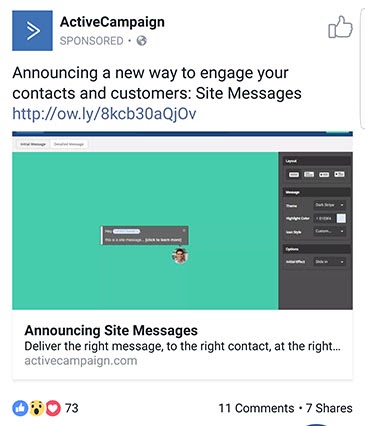
ActiveCampaign’s ad is created from screen captures
Animated videos
These videos allow you to put a twist on your brand. They also carry endless possibilities as you can create any of the video types mentioned above using this video format.
Live videos
Again, a live video, like animated videos can be used to create any of the video formats we’ve already mentioned. The advantage of Live video is the lower production cost and minimal time requirements.
8. Add emotion to your ads
You have a lot of different emotions, and your customers do too.
In fact, a study of over 1400 successful ad campaigns found that campaigns that focused entirely on emotion nearly doubled (31% vs. 16%) the performance of their non-emotional counterparts.
The takeaway: You can cash in on this and use emotional content as part of your Facebook ads strategy to improve its performance.
If you pick the right emotion, you’ll grab your customers’ attention. You may even get them to tag their friends or make a purchase. Try to put yourself in your customers’ shoes. Target the emotions your customers might feel before they decide to buy your product or service.
For example, you may not want to scare your customers, but that’s exactly what this Facebook ad from Castle of Chaos aims to do:
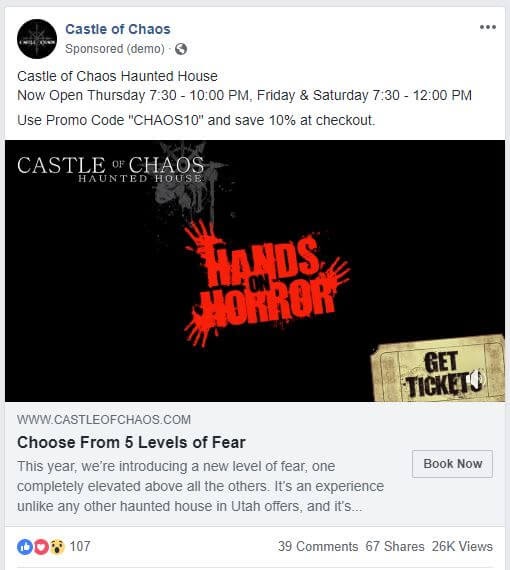
This ad plays on emotions
Facebook ads provide you with more than one way to apply emotion. The perfect ad will combine the right images and written copy to grab your customers’ attention. When done correctly you’ll earn you a click and maybe even a purchase.
There is an endless number of emotions you can use from scary to funny; you name it you can use it. Here are a few of the most effective emotions you can sprinkle into your ads:
- Happy
- Sad
- Angry
- Disgust
- Scared
9. Use FOMO (fear of missing out) to your advantage
Imagine you’re sitting home alone just kicking back on your comfy couch feeling content. You’re happy that the week is over and you can finally relax. When suddenly you feel an overwhelming compulsion come over you and you give in to the temptation. You decide to pull out your phone and scroll your Insta feed.
Within minutes your relaxing Friday night was turned upside down. Literally, all of your friends went to Cabo without you. That girl/guy you like posted a picture of what appeared to be the wildest Friday night party you’ve ever seen. We’re talking project X stuff!

We all fall for FOMO sometimes – Image source
Okay, I think you get it. We’ve all been there before, and it instantly jolts you into a state of fear. Fear of missing out that is, you don’t want to be the only one who had a boring weekend.
The good news is you can tie into your customers’ natural tendency to fear missing out on something with the following tactics:
- Use social proof – Show how many people are already using your product or service.
- Pose a question – Ask a question that hints he or she may be missing out on something.
- Make it exclusive – Indicate there is an exciting event, lesson, or benefit open to members only.
- Make it limited time – Use a limited time offer to add urgency and indicate that others are taking you up on your offer.
For example, the sale ad by Benefit Cosmetics emphasizes the urgency by telling people to go and show “NOW” and offering additional perks like free shipping to convince even the doubters.
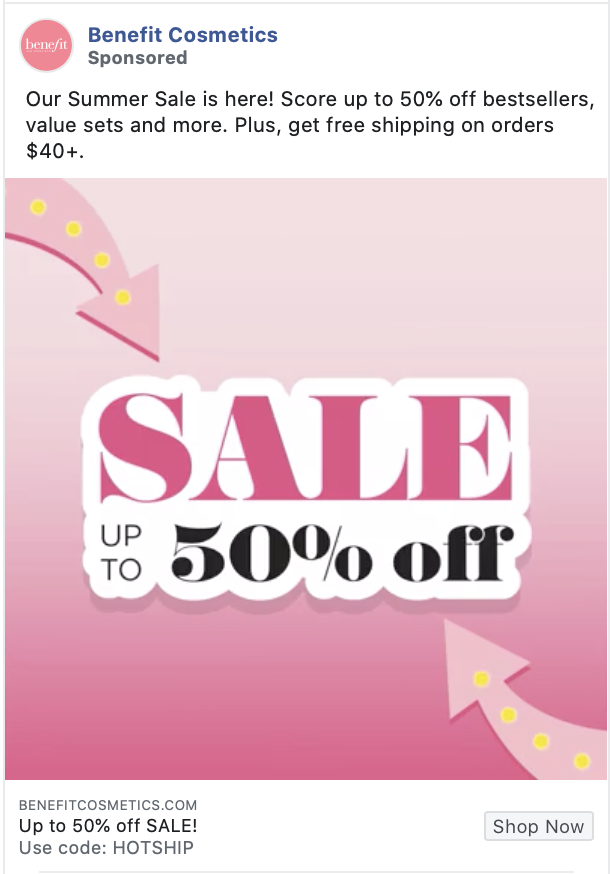
Benefit sales ad
10. Create curiosity
Not using curiosity to your advantage could cost you a lot of potential customers. So how can you plug into your audience’s curiosity and score some higher CTRs?
Even though you can’t use pop-ups to get your customers clicking on your Facebook ads, you can apply the same principles.
Since your customers are naturally curious, all you need to do is give them a little nudge.
Let’s take a look at a few strategies you can use to spark some curiosity with your customers:
Try using a Facebook Carousel Ad and only reveal the secret on the last slide. You can advertise a special offer or discount code. Then let them know they have to go to the last slide to find the code. This will encourage your customer to scroll all the way to the end and make them more likely to click on your ad.
Which is exactly what Discover Card did in this Facebook ad:
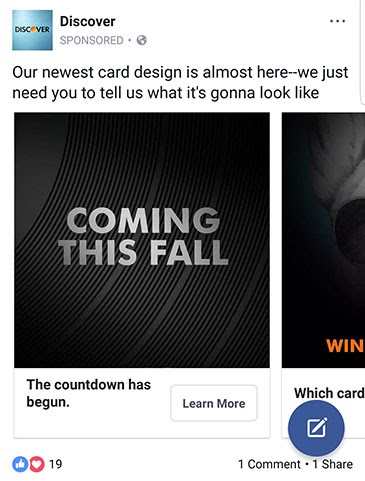
This carousel ad plays on curiosity
With a little bit of curiosity, you can get more engagement from your Facebook ads and drive more customers to download your content offers.
Check out this Facebook ad from Leadpages that lures you in with some curiosity:
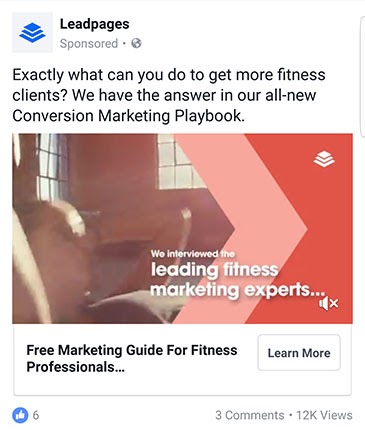
Ask a question and provide an answer after the click
11. Promote giveaway campaigns to gain new fans
Here’s a more efficient way to build brand awareness and get people to engage with yourself: running giveaways on Facebook and Instagram. ❤️
Check out this example of an Instagram giveaway by @WTFoliage Instagram account that gives a free plant to two people. To participate, people have to follow the Instagram page and tag a friend.
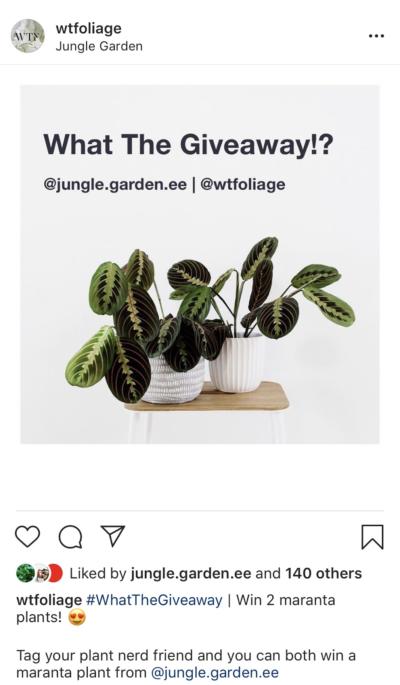
Instagram giveaway ad by @wtfoliage
You can also run giveaway campaigns to engage your existing users or target remarketing audiences.
12. Offer a special (and limited-time) discount
Think about the last time you made a purchase decision that you were extremely happy about.
You know… the one that you didn’t regret, one that made you feel good. If you thought of a time you got a great deal or caught an item that was almost sold out you’re not alone.
According to a study by coupons.com, customers that received a discount coupon experienced a 38% rise in oxytocin levels and were 11% happier than those who did not receive a coupon.
You can benefit from this knowledge by creating Facebook ads that offer a special discount. You can push the envelope further by adding some time restrictions to create urgency.
Thanks to the many retargeting options Facebook offers you can apply this same principle with your past customers. Offering a discount to your current customer base builds brand loyalty and keeps customers coming back.
Take this ad by H&M for instance: They regularly offer small discounts on various product lines to boost their sales all year round. Pretty smart, huh? 💸
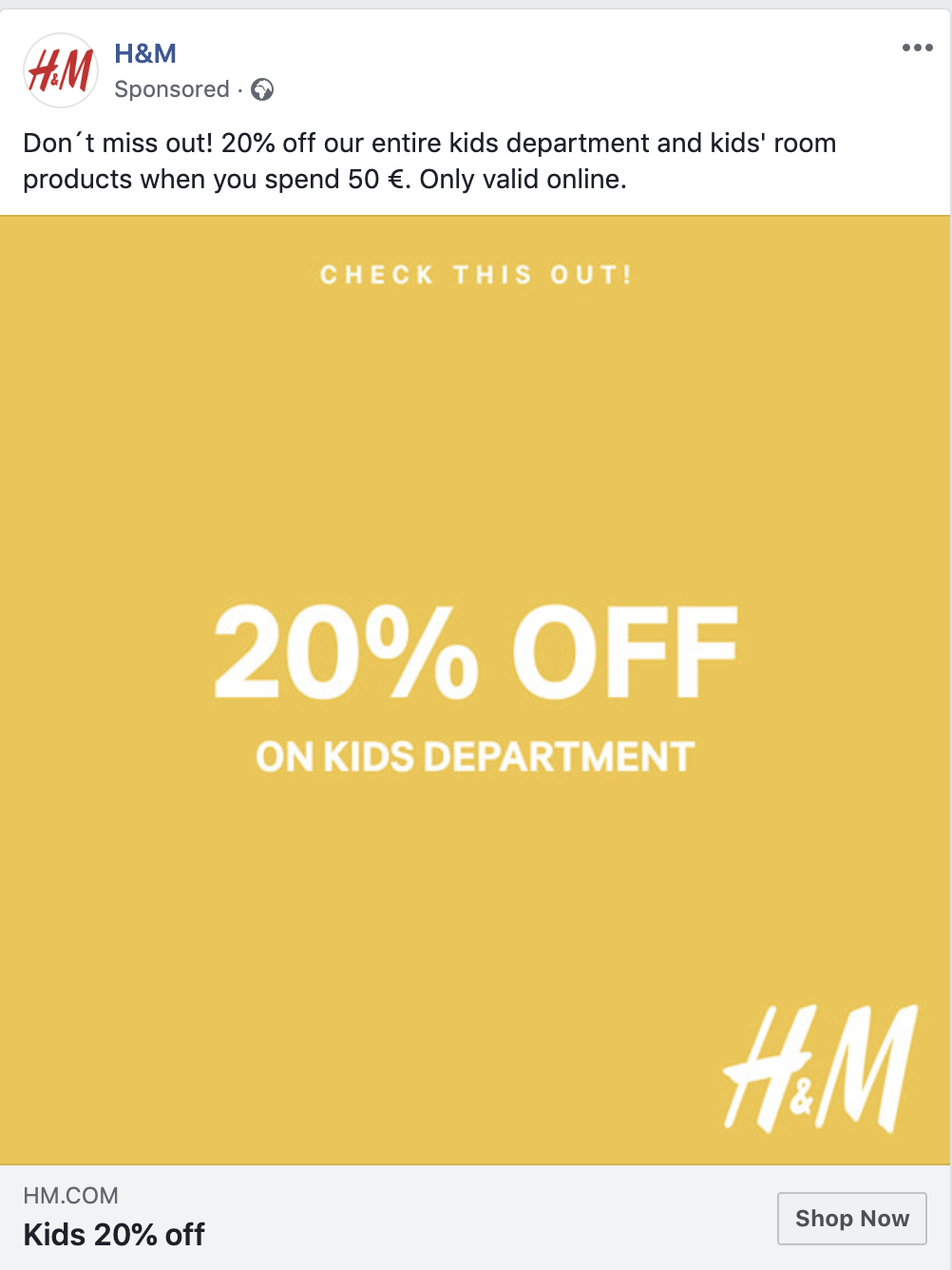
H&M is offering small discounts
Here’s one more example by Mytheresa.com – and it’s sure to catch your attention with the huge “SALE” messages flashing around.

Test placing a big “SALE” message in the ad image
Pro tip: You can expand on this Facebook ad strategy even further by asking your customers to do something for you first. You can offer a discount when your customers tag their friends, share your post, or subscribe to your email list. This is a great way to increase your average ticket value, reach a bigger audience, and turn your customers into advocates.
13. Use Facebook ads to smoke test offers
Most companies spend hours creating what they believe to be relevant and highly desirable content before they have any data to back up their assumptions. As a result, they waste countless hours of company time and resources creating an offer no one wants.
Instead of putting the cart before the horse, you can create smoke tests. Smoke tests help you discover which offer will perform the best before you actually make anything. 🍪
Start by dreaming up three or four offers that you think your target audience will find interesting. Then create a fake landing page for each of your offers. Just make sure it looks like it’s broken after your visitors convert. This is important since you won’t actually be sending them anything.
Next, you’ll drive traffic to your landing pages by creating a Facebook ad for each of your offers. Be sure to give each ad the same audience, budget, and duration. This will ensure your test is statistically significant.
Oh, and pay attention to the duration! You don’t want to continue frustrating visitors for an extending period. You just need enough data to indicate a clear winner. The winning offer, of course, will be the one with the most conversions.
Now that you know what your audience wants, make sure you create the offer (for real this time). Then implement one of the other strategies in this article to start raking in conversions.
14. Test first, spend later
It’s okay to make mistakes, but if you’re smart, you probably try not to make the same mistake more than once.
Unfortunately, we’ve seen too many people make mistakes advertising on Facebook. They lose a lot of money and swear never to spend another dime on Facebook ads. If you’re one of those people, you might want to consider giving it another go with the Facebook ad strategies we’re about to show you.
If you’ve ever punished your entire mouth with a flaming hot sip of coffee, you know what I’m talking about.

Try not to get burned with Facebook ads! – Image source
Similarly, in the land of Facebook ads, you can avoid getting burned and stretch your advertising budget a lot further if you test your ads before dumping money into them.
For example, Asana is regularly adding new ad creatives to their Facebook ad campaigns to see what works the best.
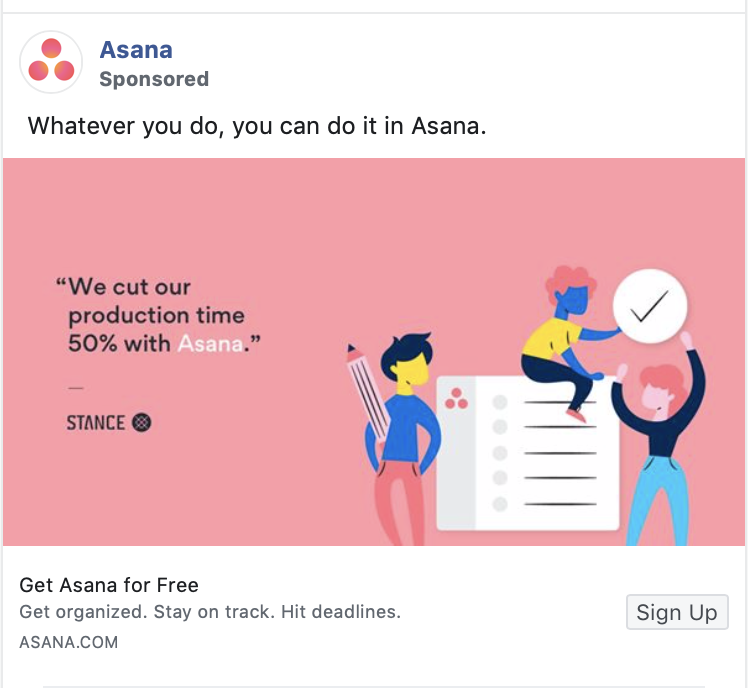
Asana ad example 1
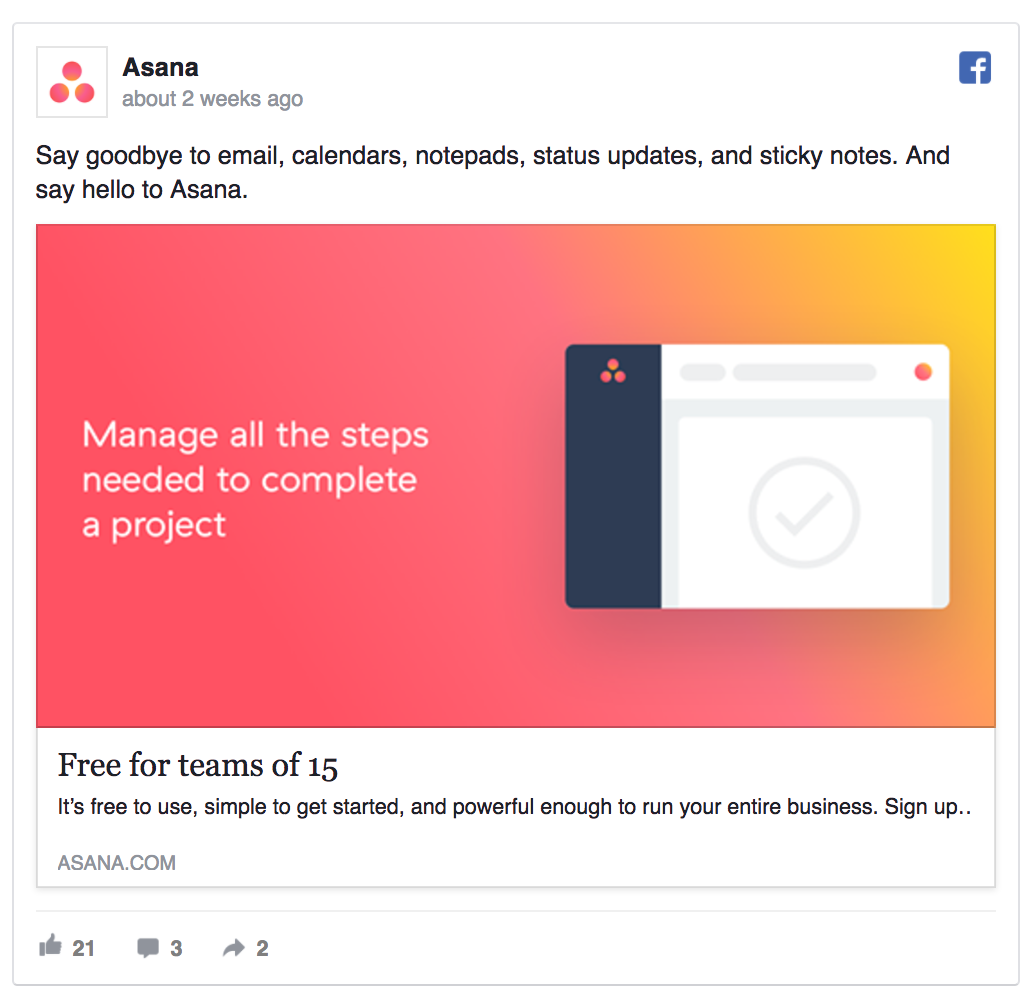
Asana ad example 2

Asana ad example 3
Fortunately, Facebook has a built-in split testing system that will make this process a breeze. All you have to do is think up some variations of your ad. Then give it a small budget and Facebook will do the rest of the number crunching. After the test is complete Facebook will spit out the winning ad.
You can set up a Facebook ad A/B test in the Ads Manager by ticking an extra box during the campaign setup.
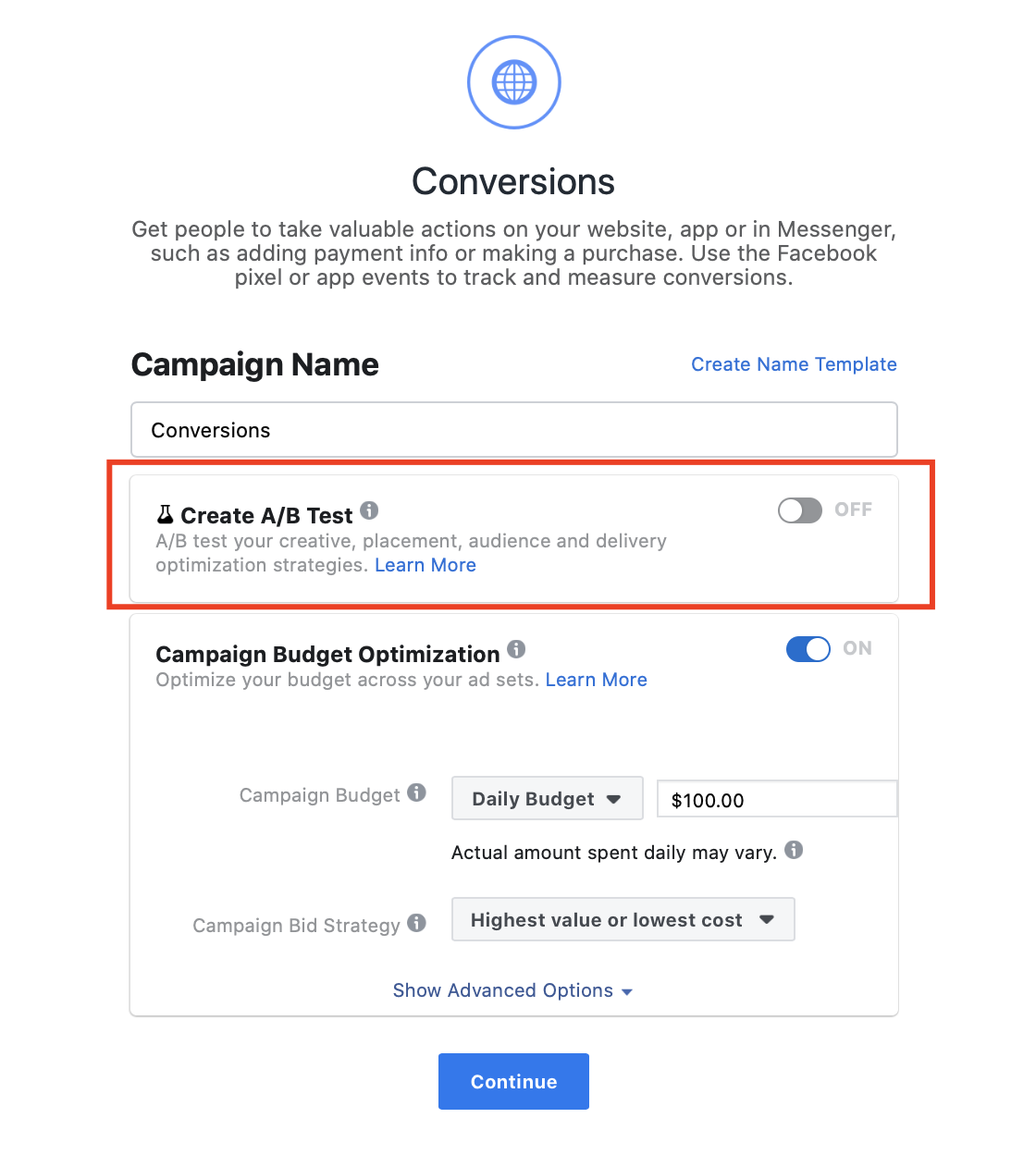
Setting up Facebook ad A/B tests is easy!
Below, we’ve outlined the different creative elements you can test. You’ll also find a few testing ideas to help you get started:
Ad types
You can test all of the different ad formats Facebook offers including:
- Video ads
- Image ads
- Collection ads
- Carousel ads
- Sideshow ads
- Lead gen ads
- and more
Creative
You can test all kinds of image variations like:
- Dark images vs. light
- Generic vs. specific
- With your logo or without
- Text in the image or no text in the image
- A million other variations!
Although we’ve seldom seen good results with text-only ads, you could even try testing the ad without an image at all.
Ad copy
You can test all different text combinations such as:
- Long and short titles
- Asking questions vs. making statements
- Positive vs. negative headlines
- With or without a testimonial
- With a CTA or without
You can even try adding emojis to your ad copy and compare the results with and without them.
CTA’s
You can test out all of the available CTA buttons like:
- Apply Now
- Contact Us
- Download
- Get Showtimes
- Learn More
- Listen Now
- Send Message
You can even try testing the ad without a button at all just choose the “No Button” option from the list.
15. Test different audiences and offers
Trying out different offers and audiences is a great way to dial in your overall Facebook ads strategy.
When you are just beginning your Facebook ads journey, it’s important to front-load the creation of audiences. This way you can test variations and find audiences with the highest conversion rates and the lowest costs.
Here are a few of the audience variations you could test:
- Different Lookalike Audience sizes: 1%, 2%,3%,4%, and 5%
- Various Custom Audience Duration: Past 30 days, Past 60 days, Past 90 Days, etc.
- Separate Saved Audience Variations: Location, Demographics, Interests, Behaviors, etc.
To learn more about Facebook ad targeting, read this article: Facebook Ad Targeting in 2020 – Reach the Right Audience for Higher ROI
Facebook even provides you with a built-in tool for split testing your audiences. When you create a new campaign just toggle the split test option then select Audiences from the list.
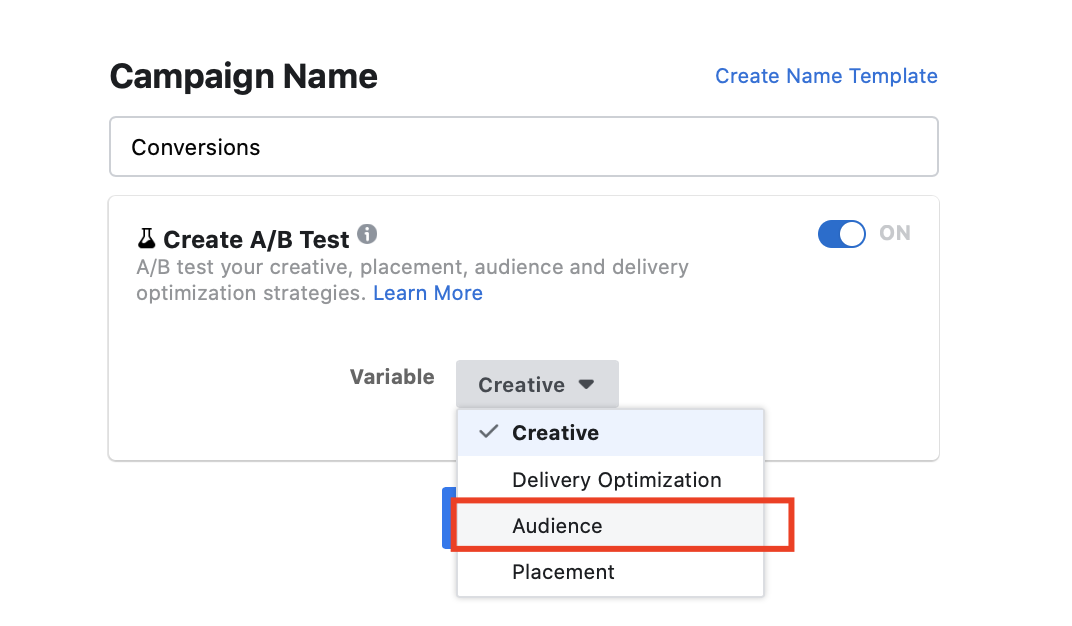
Split test various Facebook audiences
It would help if you also considered testing different offers with each audience. It’s likely one offer will perform better than another dependent on the visitors’ stage in the buyer’s journey.
You can mix and match all of your offers with the different audiences you’ve created. This will help you find out what offer works best for that particular customer segment.
To begin testing your Facebook audiences, make sure you have at least two different audiences that don’t overlap with one another. You can prevent overlap by using the exclude feature to exclude custom audiences.
After a few tests, you should start to see audiences and offer combinations that outperform the rest.
16. Combine Facebook Ads With Google ads
Adding Google Ads to your Facebook ads strategy is like smearing soft butter on a warm piece of toast. It’s a match made in heaven.

Mix your Facebook and Google ad strategies
Here’s a recipe that will teach you how to create your very own slice of Facebook advertising heaven.
Facebook ads + RLSA
You’ll start by creating ads targeted at getting your potential customers to visit your website. Then you’ll create RLSA (Remarketing List Search Ads) in Google Ads. Now, you can remarket to all the website visitors you’re getting from your Facebook Ads.
This will allow you to bid higher on keywords when previous website visitors search for one of your keywords. Because you know they’re familiar with your company and more likely to convert you can increase your bids. Raising bids for past visitors will also help you outrank your competition. Especially when your visitors search for a product or service you both offer.
For example, Buffer could run Facebook ads to drive people to their blog at a low CPC cost. And later on, they could set up Google remarketing ads to convert the blog visitors into customers.
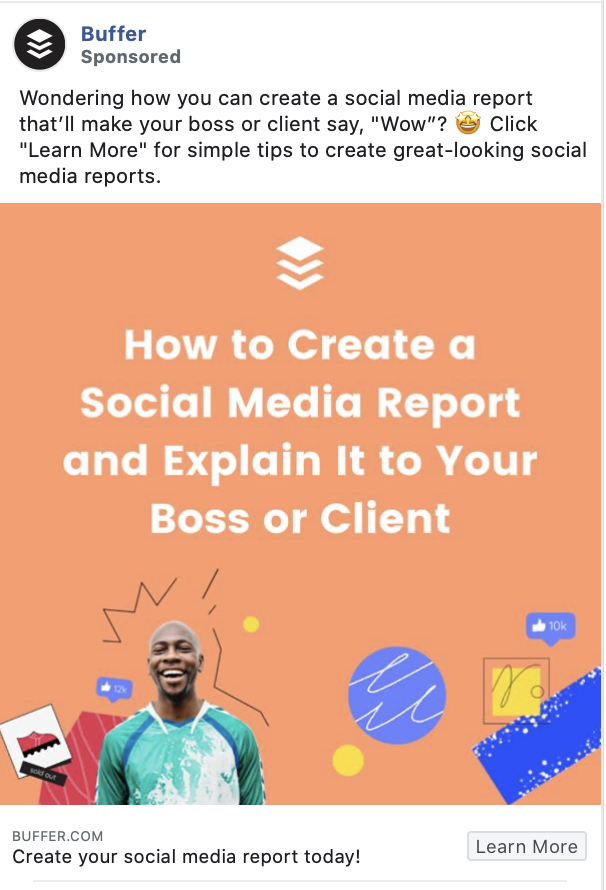
Buffer’s ad is great for lead generation
Additionally, you can choose the targeting option in Google ads to only have your ads shown to past website visitors. This is a go-to strategy no matter what you’re trying to accomplish.
Especially for industries that have unusually expensive keywords. You might also benefit from this strategy if you’re just starting your PPC journey and have a limited budget. 💰
Pro tip: It’s best to keep the CPC low as you’ll be paying for additional clicks in Google ads. For this reason, we’ve seen ads for promoted blog content work well, and it’s usually relatively inexpensive. With the right ads and audience, you should be able to reel in landing page visits for well under a dollar.
17. Optimize your bidding strategy
Designing great images to pair with engaging copywriting is critical to your Facebook ad performance. Be that as it may, your bidding strategy will decide who sees your ad. Including how often they see it, and how much you’ll pay.
When you create a new Facebook campaign, you’re entering a global auction. That means you’ll be competing with millions of advertisers for the best placements Facebook has to offer. So if you haven’t tinkered with your bidding strategy on Facebook, then now’s the time to start.
If you don’t use the right bidding strategy, you could end up paying too much for your ads. As a result, eliminating any chance you had of being profitable. Bidding low isn’t always the solution either.
Think about all the time and hard work you put into making your ads. Then imagine it all amounting to nothing because you bid too low and no one ever sees them.
Like most Facebook ad strategies we’ve covered in this article, the right bidding strategy will vary depending on your audience and offer.
Here are the bidding strategies Facebook offers:
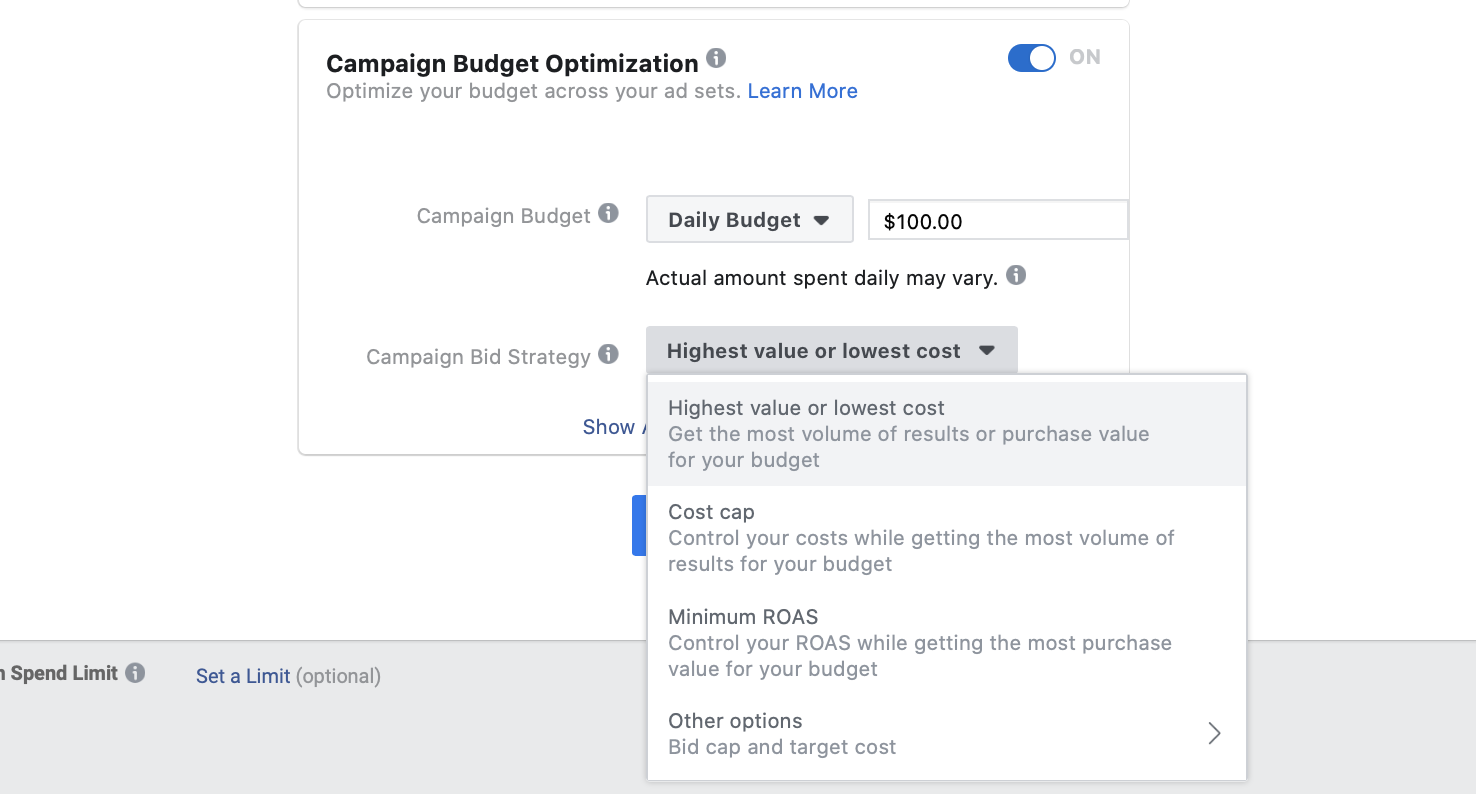
Facebook add strategies for bidding
Let’s take a closer look at each of these options.
Highest value of lowest cost
This is the default bidding strategy that Facebook will choose for you. This bidding strategy optimizes your ads to get the most results for the lowest possible CPC. If you don’t have any idea what you should bid then this is a good place to start. Then you can take a look at your reporting and figure out what to bid on future campaigns.
Cost cap
With this strategy, you’ll be able to set a target cost for your bids. This gives you more control than the lowest cost bidding strategy. As a result, you can get better placements, but you may also spend a bit more. If you know how much you can afford to spend per result this bidding strategy might be your best option.
Minimum ROAS
To use this bidding strategy, you first need to share the purchase values with Facebook. This can be set up in the Events Manager with the Facebook Pixel. By using this bidding method, you can tell Facebook what’s the minimum return on ad spend you want to achieve. Facebook will optimize your ad delivery to users wwho are most likely to purchase at higher values.
Lowest cost with cost cap
This strategy helps you keep your cost low by allowing you to define a maximum cost per result. You’re guaranteed to never pay more than you want for results. This is an excellent bidding strategy to use once you know how much results should cost. It can also be your go-to strategy for smoke tests or other low budget campaigns.
Tip: You can test all these strategies to find which one works best for you.
18. Separate mobile and desktop ads
Mobile advertising makes up the majority of all advertising revenue on Facebook. This means you can get better results by creating ads that are optimized for mobile users.
Tip: Before you start creating mobile ads, make sure you landing page loads quickly on a mobile network. It’s important to produce a great user experience even on smaller screen sizes.
It’s also important that you don’t forget about your desktop users. Mobile and desktop newsfeed ads both perform better with slightly different features.
Mobile
The font size on Facebook mobile ads is much smaller. They don’t stand out as they would on a desktop view making them less important. This means users are much more likely to pay attention to the main text portion of your ad. Making your text the most crucial part of your mobile ads copywriting.
This is especially important if your Facebook ad strategy involves ads for a mobile app.
Desktop
Headlines grab the most attention from desktop users. This gives them a more significant effect on your Facebook desktop ads performance. Additionally, desktop ads see improved performance when they include longer News Feed link descriptions.
Here’s a quick comparison, so you can see what we’re talking about:
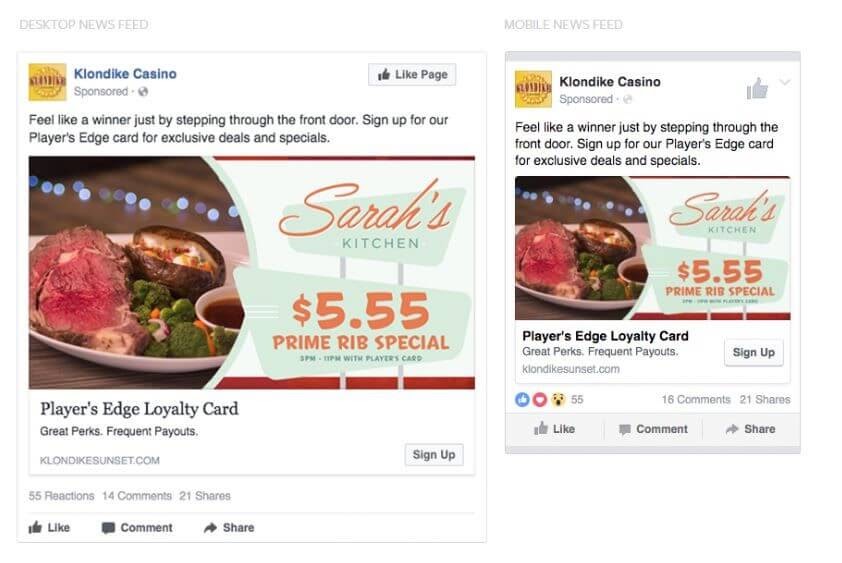
How desktop and mobile Facebook ads look like
If you’re like most people, your eye goes straight to the headline on the desktop ad. Conversely, you focus in on the main text in the mobile version.
You can optimize your Facebook ads strategy even more by crafting different ads for Instagram mobile placements.
Start to isolate your Instagram ad placements with their campaigns specifically created for your Instagram ads. This will allow you to easily track their performance and customize your ad to the specifications of the platform.
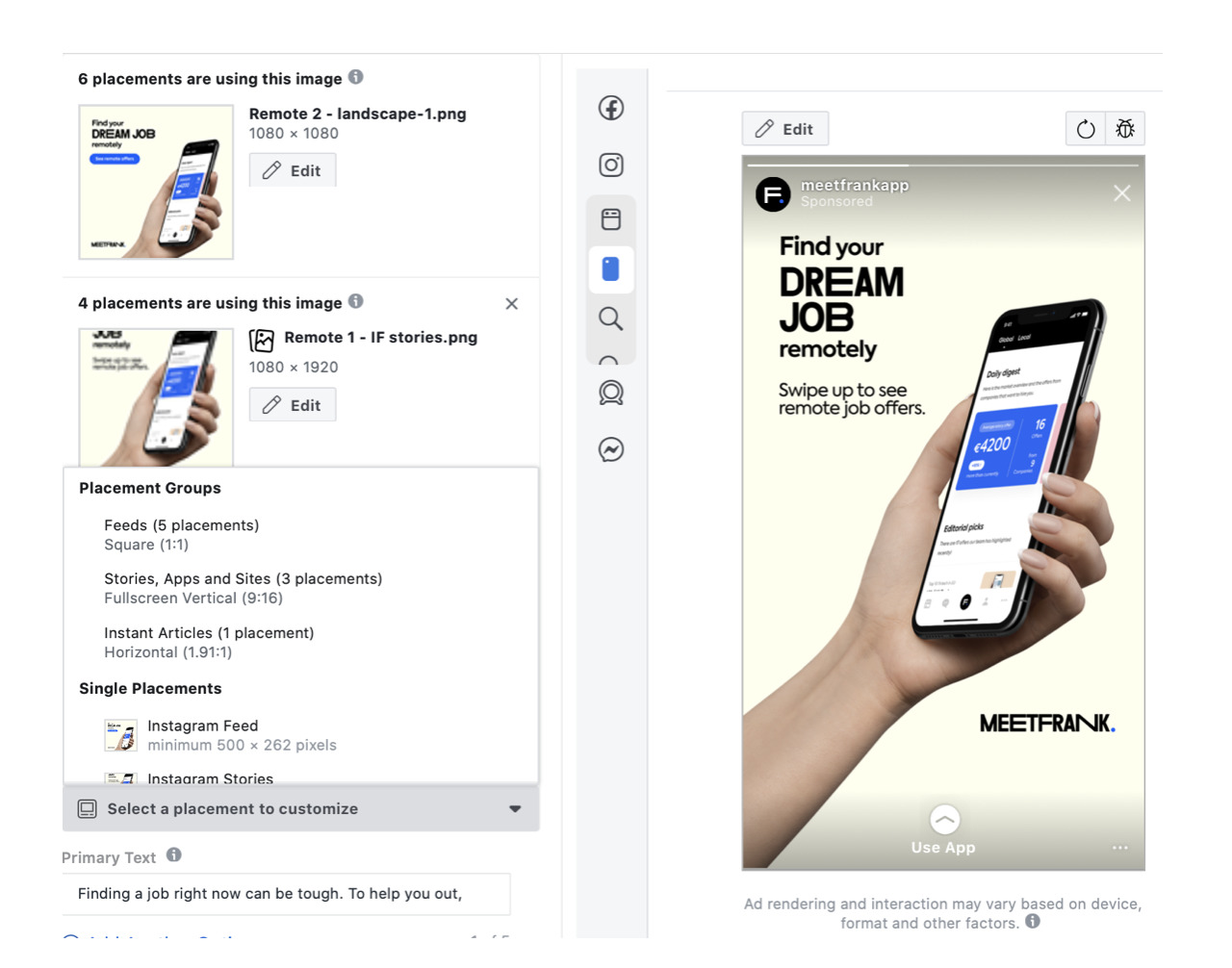
You can upload multiple ad formats for various placements
Instagram is a primarily visual platform with users giving less attention to the written content below your image. So, you should choose visuals that grab users’ attention.
For example, Bolt Food uses very different ad creatives for Facebook News Feed and Instagram Story ad placements.
Here’s one of their Facebook News Feed ads:
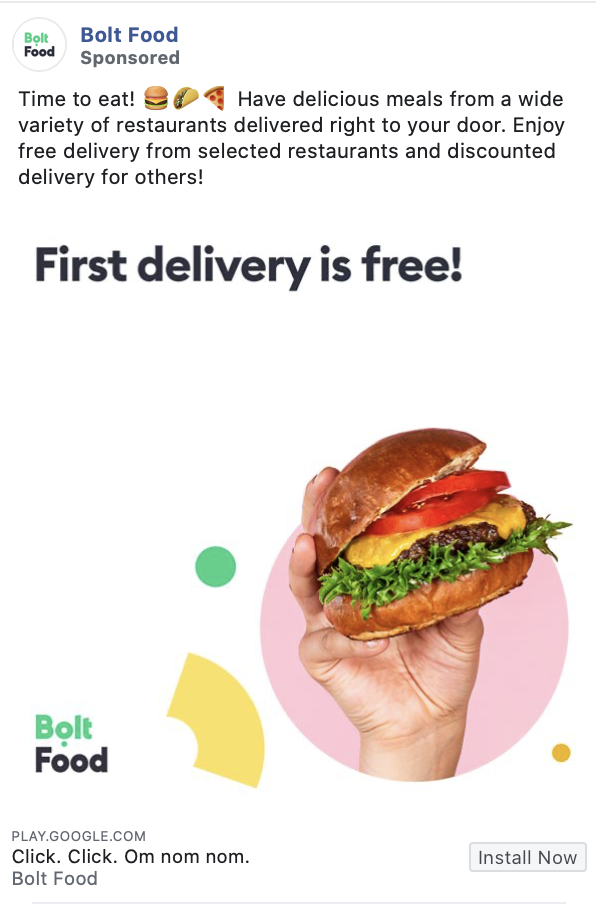
Bolt Food Facebook ad
And here’s an Instagram Story ad example. Notice how the ad design makes good use of the portrait format and the opportunity to show the mobile app screen.
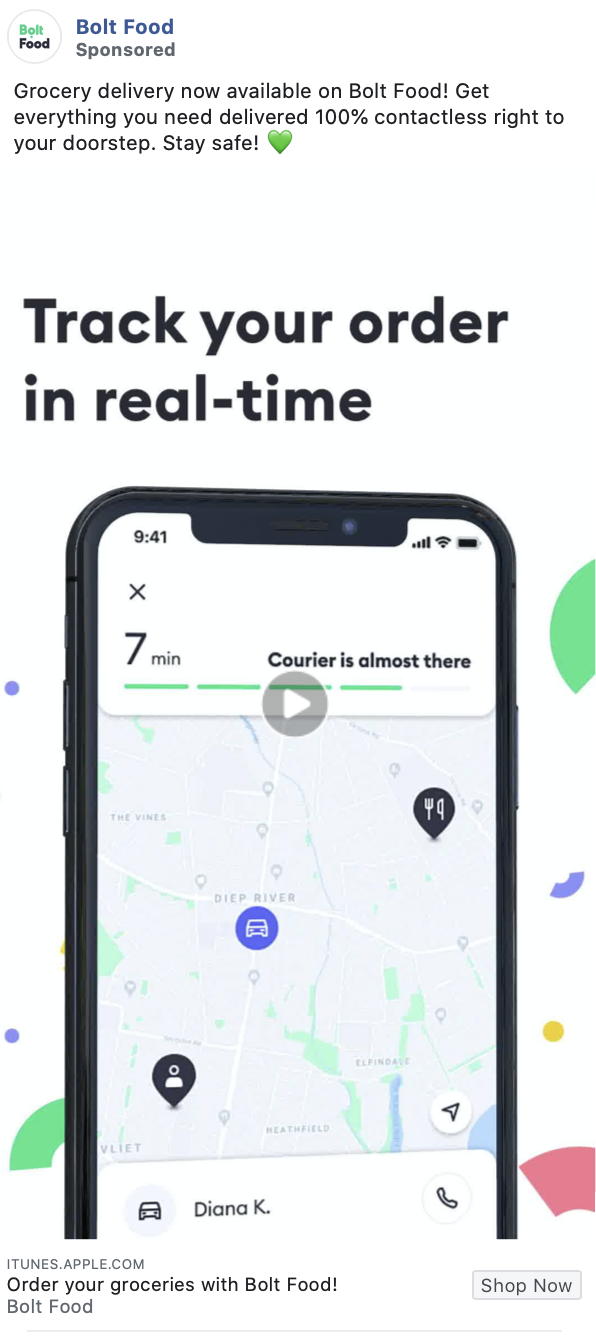
Bolt Food Instagram Stories ad
Additionally, you can give carousel ads a chance on Instagram. It’s likely to get more interaction from the platforms visually focused users. Just make sure to pay attention to your first image as it will be responsible for any engagement you receive.
19. Use Facebook lead ads
Lead ads are a great way to simplify your conversion process. Many times they can drastically lower your cost per lead.
In one study by ladder.io, they were able to lower their cost per lead by over 80% using Facebook lead ads.
So how does the Facebook ad strategy with lead ads work?
Lead ads look very similar to any other Facebook ad in your newsfeed. They contain an image, text, a headline, display link, and newsfeed description. Instead of sending visitors to a landing page, lead ads trigger a pop-up with your customers’ information already filled out. This makes it easy for customers to convert on your offer without ever leaving Facebook.
Like other Facebook ad strategies, lead ads come with a few best practices you’ll want to note:
- Make sure your ad provides value by clearly stating what your customers will get in exchange for their information. (Simply put explain what’s in it for them.)
- Offer a great incentive, like free downloadable content or a free trial.
- If you’re an eCommerce company, use a sizeable discount as an incentive.
- Include a simple call to action that tells customers what to do and how easy it is.
Here’s an example of a lead ad by AdEspresso, offering an e-book in exchange of the person’s email.
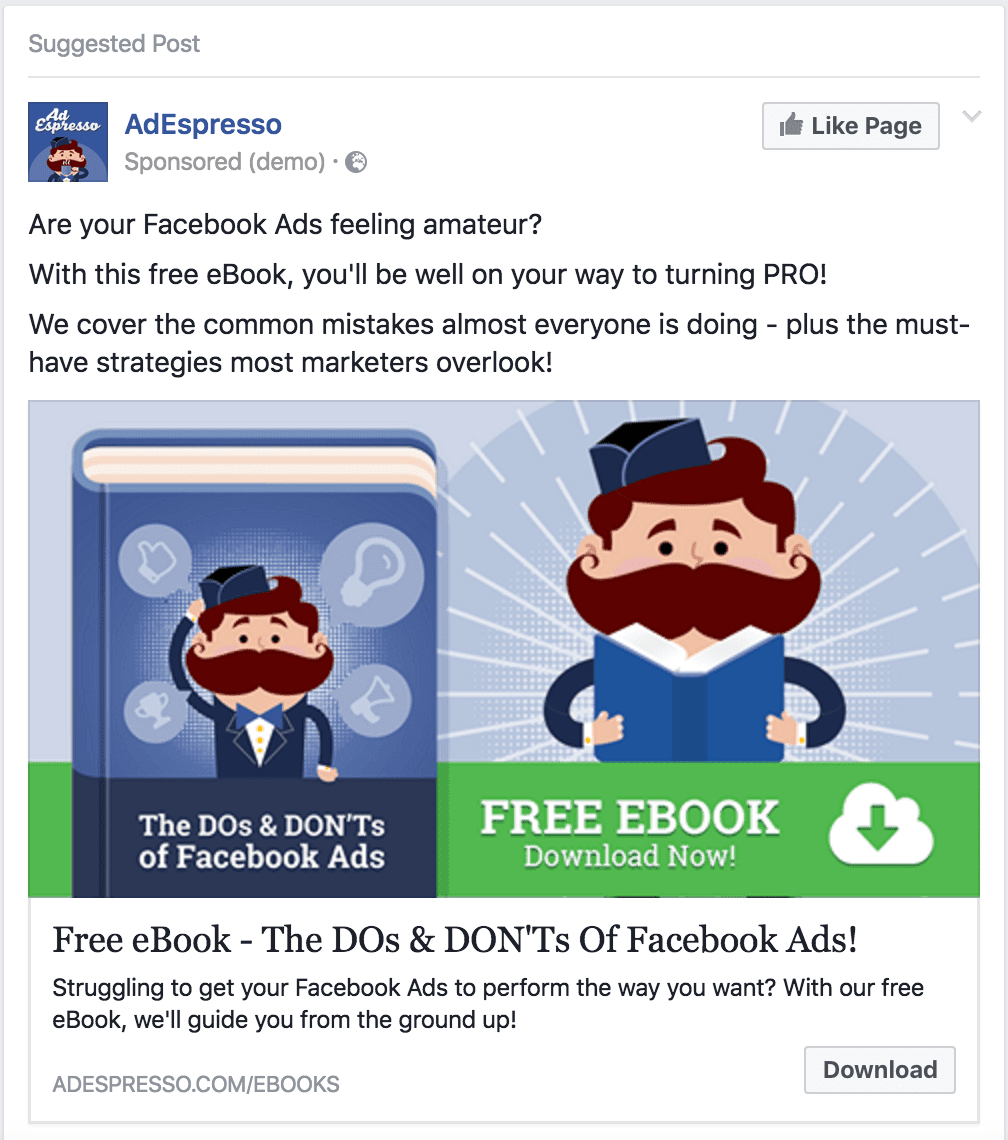
Facebook lead ad example
Pro tip: Lead ads are an especially good Facebook ad strategy if you’re targeting mobile users. Mobile users are more likely to convert on your offer when you use lead ads instead of a landing page.
Here’s how you can implement a lead ads strategy in your own Facebook campaigns:
- Create a brand awareness or traffic ad to drive traffic to your website or blog.
- Next, create a remarketing audience to target website visitors in the past thirty days.
- Then, create a desktop-only remarketing campaign that sends visitors to a landing page to collect their information.
- After that, create a mobile-only remarketing campaign that uses lead ads.
- Finally, compare the results, and as always test this strategy for yourself to make sure this strategy works for you!
Tip: If your only goal is growing your mailing list then just ask for their name and email. Don’t go bonkers with the questions, and you’ll get better results. 😌
20. Tell a story with carousel ads
Carousel ads are some of the coolest ads on Facebook. For starters, Facebook themselves boasts that Carousel ads sport a 30-50% lower cost per conversion when compared to single image ads.
Carousel ads work because they’re visual and interactive at the same time. With a little bit of creativity, you can use carousel ads to attract visitors who’ve never heard of your product, upsell existing customers, and everything in between.
You can use Carousel Ads with up to ten slides to tell a story about your business, product, or service. This is a great way to highlight your products, features, and benefits before the customer even leaves Facebook.
Below you can see an excellent Facebook Carousel ad by Purple Mattress: The ad creative rund through multiple carousel cards.

Cool Facebook carousel ad example
The creation process is very similar to other Facebook ad types. However, Carousel ads have some unique requirements that differentiate them from other ad types.
Here are the basic rules you’ll need to follow when creating carousel ads:
Resolution: 1080 x 1080 pixels (recommended)
Headline: 40 characters
Text: 125 characters
You can find much more in-depth specifications on Facebook’s official guide to carousel ads.
Tip: The best carousel ads trigger your curiosity and urge you to move on to the next slide. If you’re telling a story or demonstrating your product you can leave a cliffhanger on the first slide or two. Make sure that it’s interesting enough to get your customers’ attention.
21. Use dynamic ad creatives
Are you on the verge of a panic attack from creating hundreds of different Facebook ads? If you are then don’t check yourself in just yet. We’ve got the perfect Facebook ad strategy to save you some time and hopefully calms those nerves a bit.
Facebook Dynamic Creative tool allows you to test over 30 creative assets at the same time.
After a learning period, Facebook will automatically choose what it deems to be the best combination. This is the perfect Facebook ads strategy to test different ad copy variations, images, and CTAs.
Here’s a list of everything you can test at once with the dynamic creative tool:
- 5 Headlines
- 10 Images/Videos
- 5 Descriptions
- 5 Call to action buttons
To set up dynamic creative you’ll need to enable at the ad set level before creating your ad. Once activated you’ll see something similar to my example below:

How to set up Facebook dynamic ads
Choose your images and fill in each text section with the different headlines, text, and descriptions. Now you can run your test, and walla, you’re off to the races!
Tip: You don’t have to test everything, just because the option is available. That might even be a really not so good idea.
For example, if you’re an eCommerce company, you don’t need to test any of the CTAs other than shop. That’s because it’s obviously the most relevant and accurate option.
22. Scale your budget
If your current Facebook ad campaigns are profitable then it might be time to increase your budget. Scaling Facebook ads is the perfect way to increase your lead/sales volume.
Increasing the budget for already profitable campaigns is like pulling off a sweet unicycle jump.

Scaling can be difficult – Image source
It can be pretty tricky. But if you get it right the results are well worth it.
Your goal here is to get more leads and sales without increasing your cost per result. In order to do that there are several tips, you’ll want to keep in mind.
- Increase budget gradually in small increments over time
- Wait for each learning phase to complete before making additional changes
- Set up automated rules to increase budget at the right time
- Use campaign-level budget control
As I mentioned previously, this is a tricky strategy to pull off. If you don’t do things just right you can burn through all your extra ad spend without improving results. Which would totally suck.
So to make sure that doesn’t happen we created a step by step guide to scaling Facebook ads.
Get creative with your Facebook ad strategies
Hopefully, you’ve been inspired by all of the strategies in this article, and you’re ready to get creative.
Being creative is the most important thing you can do to ensure your success on Facebook. Don’t follow the crowd and do what everyone else does. You don’t always need to follow best practices either. Sometimes you have to bend the rules a bit to find what performs best.
Take advantage of the cheap testing options Facebook provides. Before you pour big bucks into a campaign and don’t be afraid to try new things.
Start today and in time you’ll find something new that works for you.
Luke Heinecke
Founder/CEO
Luke is in love with all things digital marketing. He’s obsessed with PPC, landing page design, and conversion rate optimization. Luke claims he “doesn’t even lift,” but he looks more like a professional bodybuilder than a PPC nerd. He says all he needs is a pair of glasses to fix that. We’ll let you be the judge.
Leave us a comment.
Subscribe to our blog
Subscribe to our blog
Get weekly PPC & CRO advice sent straight to your inbox.